As a parent of a child with autism spectrum disorder (ASD), navigating the world of therapy options can be overwhelming. Applied Behavior Analysis (ABA) therapy is widely recognized as one of the most effective treatments for children with ASD. However, not all ABA providers are created equal, and finding the right one for your child is important for their well-being. Here are some key factors to consider when identifying a quality ABA provider:
1. Individualized Treatment Plans:
A quality ABA provider will conduct a comprehensive assessment of your child’s skills and then develop a tailored treatment plan based on their unique needs and preferences. Avoid providers who offer a one-size-fits-all approach, as each autistic child requires personalized intervention strategies.
As part of the assessment process, a quality ABA provider will utilize a standardized assessment tool to thoroughly evaluate your child’s skills, deficits, and areas of need. This ensures a comprehensive understanding of your child’s strengths and challenges, forming the foundation for an effective treatment plan. Additionally, a provider who regularly employs standardized assessments demonstrates a commitment to evidence-based practices and objective progress measurement over time.
2. Evidence-Based Practices:
Effective ABA therapy relies on evidence-based practices supported by scientific research. Inquire about the specific techniques and methodologies used by the provider and ensure they have empirical support. Avoid providers who endorse unproven or controversial treatments lacking empirical backing.
3. Collaboration and Communication:
A quality ABA provider involves you as an active participant in your child’s therapy journey. They listen to your concerns, answer your questions, and collaborate with you to set meaningful goals for your child. Additionally, they provide regular progress updates and opportunities for you to provide feedback and input.
4. Qualified and Compassionate Staff:
The therapists and staff members who work with your child should possess not only the necessary qualifications and training, but also a genuine passion for helping children with ASD thrive. Observe how the staff interact with your child and assess their level of patience, empathy, and professionalism.
5. Services Across Environments:
A quality ABA provider offers services to meet your child’s needs wherever they require them, including home, school, and community environments. They should also provide parent training and support you in implementing ABA principles and techniques outside of therapy sessions.
6. Transparency and Accountability:
Choose a provider that is transparent about their policies and procedures. They should be responsive to any concerns you may have and take proactive steps to ensure accountability and quality assurance.
Finding the right ABA provider for your child may require time and effort, but it is a worthwhile investment. By considering these factors and trusting your instincts as a parent, you can ensure that your child receives the high-quality ABA therapy they deserve.
Effective ABA therapy relies on evidence-based practices supported by scientific research. Inquire about the specific techniques and methodologies used by the provider and ensure they have empirical support. Avoid providers who endorse unproven or controversial treatments lacking empirical backing.
3. Collaboration and Communication:
A quality ABA provider involves you as an active participant in your child’s therapy journey. They listen to your concerns, answer your questions, and collaborate with you to set meaningful goals for your child. Additionally, they provide regular progress updates and opportunities for you to provide feedback and input.
4. Qualified and Compassionate Staff:
The therapists and staff members who work with your child should possess not only the necessary qualifications and training, but also a genuine passion for helping children with ASD thrive. Observe how the staff interact with your child and assess their level of patience, empathy, and professionalism.
5. Services Across Environments:
A quality ABA provider offers services to meet your child’s needs wherever they require them, including home, school, and community environments. They should also provide parent training and support you in implementing ABA principles and techniques outside of therapy sessions.
6. Transparency and Accountability:
Choose a provider that is transparent about their policies and procedures. They should be responsive to any concerns you may have and take proactive steps to ensure accountability and quality assurance.
Finding the right ABA provider for your child may require time and effort, but it is a worthwhile investment. By considering these factors and trusting your instincts as a parent, you can ensure that your child receives the high-quality ABA therapy they deserve.
The therapists and staff members who work with your child should possess not only the necessary qualifications and training, but also a genuine passion for helping children with ASD thrive. Observe how the staff interact with your child and assess their level of patience, empathy, and professionalism.
5. Services Across Environments:
A quality ABA provider offers services to meet your child’s needs wherever they require them, including home, school, and community environments. They should also provide parent training and support you in implementing ABA principles and techniques outside of therapy sessions.
6. Transparency and Accountability:
Choose a provider that is transparent about their policies and procedures. They should be responsive to any concerns you may have and take proactive steps to ensure accountability and quality assurance.
Finding the right ABA provider for your child may require time and effort, but it is a worthwhile investment. By considering these factors and trusting your instincts as a parent, you can ensure that your child receives the high-quality ABA therapy they deserve.
Choose a provider that is transparent about their policies and procedures. They should be responsive to any concerns you may have and take proactive steps to ensure accountability and quality assurance.
Finding the right ABA provider for your child may require time and effort, but it is a worthwhile investment. By considering these factors and trusting your instincts as a parent, you can ensure that your child receives the high-quality ABA therapy they deserve.
Parenting an autistic child brings unique challenges, including an increased likelihood of sleep disturbances. According to the National Institutes of Health, 50-80% of autistic children experience sleep disturbances in comparison with 20-30% of neurotypical children. Behavior Analysts often provide individualized consultation to parents related to sleep, as part of a child’s ABA therapy program. The most common sleep challenges reported by parents are sleep onset issues, sleep awakenings, and night-time sleep that is not long enough.
For our first blog post in this sleep series, we will share a few tips related to helping your child to fall asleep more easily.
1. Create Consistent Bedtime Rituals:
Autistic children thrive on routine and predictability. Establishing a consistent bedtime routine can signal to your child that it’s time to wind down. Include calming activities such as reading a book, gentle stretching, a warm bath, or listening to soothing music. Create a visual schedule or checklist to help your child anticipate the sequence of activities each night. Consistency is important, so strive to maintain the routine even on weekends.
2. Ensure a Comfortable Sleep Environment:
Consider your child’s sensory needs when designing their sleep space. Ensure the room temperature is suitable, use blackout curtains if needed, and have a comforting blanket or favorite stuffed animal available for your child.
3. Minimize Stimulation Before Bed:
Limit stimulating activities, particularly screen time, at least an hour before bedtime. The blue light emitted by electronic devices can interfere with melatonin production. Aerobic activities that raise one’s body temperature should also be avoided a couple of hours before bedtime (e.g., no jumping on the trampoline after dinner time). Instead, encourage quiet activities like reading a book together, listening to music, practicing deep breathing exercises, or engaging in a low-energy game. By minimizing stimulation before bedtime, you help your child transition smoothly from the activities of the day to a more tranquil state, promoting a restful night’s sleep.
Autistic children thrive on routine and predictability. Establishing a consistent bedtime routine can signal to your child that it’s time to wind down. Include calming activities such as reading a book, gentle stretching, a warm bath, or listening to soothing music. Create a visual schedule or checklist to help your child anticipate the sequence of activities each night. Consistency is important, so strive to maintain the routine even on weekends.
2. Ensure a Comfortable Sleep Environment:
Consider your child’s sensory needs when designing their sleep space. Ensure the room temperature is suitable, use blackout curtains if needed, and have a comforting blanket or favorite stuffed animal available for your child.
3. Minimize Stimulation Before Bed:
Limit stimulating activities, particularly screen time, at least an hour before bedtime. The blue light emitted by electronic devices can interfere with melatonin production. Aerobic activities that raise one’s body temperature should also be avoided a couple of hours before bedtime (e.g., no jumping on the trampoline after dinner time). Instead, encourage quiet activities like reading a book together, listening to music, practicing deep breathing exercises, or engaging in a low-energy game. By minimizing stimulation before bedtime, you help your child transition smoothly from the activities of the day to a more tranquil state, promoting a restful night’s sleep.
Consider your child’s sensory needs when designing their sleep space. Ensure the room temperature is suitable, use blackout curtains if needed, and have a comforting blanket or favorite stuffed animal available for your child.
3. Minimize Stimulation Before Bed:
Limit stimulating activities, particularly screen time, at least an hour before bedtime. The blue light emitted by electronic devices can interfere with melatonin production. Aerobic activities that raise one’s body temperature should also be avoided a couple of hours before bedtime (e.g., no jumping on the trampoline after dinner time). Instead, encourage quiet activities like reading a book together, listening to music, practicing deep breathing exercises, or engaging in a low-energy game. By minimizing stimulation before bedtime, you help your child transition smoothly from the activities of the day to a more tranquil state, promoting a restful night’s sleep.
Limit stimulating activities, particularly screen time, at least an hour before bedtime. The blue light emitted by electronic devices can interfere with melatonin production. Aerobic activities that raise one’s body temperature should also be avoided a couple of hours before bedtime (e.g., no jumping on the trampoline after dinner time). Instead, encourage quiet activities like reading a book together, listening to music, practicing deep breathing exercises, or engaging in a low-energy game. By minimizing stimulation before bedtime, you help your child transition smoothly from the activities of the day to a more tranquil state, promoting a restful night’s sleep.
Teenage years are a time of transition and self-discovery for all adolescents, but for those with Autism Spectrum Disorder (ASD), this period can present unique challenges. Fostering steps towards independence during the teenage years lays the foundation for development into capable adults. Here are some strategies to support teenagers with ASD in gaining independence.
1. Establish Clear Routines, Expectations, and Structure
Predictability and consistency are key. Creating routines for daily activities such as waking up, preparing a snack, and completing homework, provide a framework for teens to follow. Visual schedules or checklists can help build independence with these routines.
2. Encourage the Development of Life Skills
Teaching practical skills such as cooking, doing laundry, managing money, and using public transportation equips teenagers with ASD with the tools they need to navigate the world with greater independence. Break down tasks into manageable steps, offer hands-on guidance, and provide plenty of positive reinforcement to bolster their confidence.
3. Foster Social Skills and Communication
Social interactions may not come easy to teens with ASD. Offering opportunities for them to practice socializing can help. Clubs that focus on your child’s interest can be highly reinforcing. Role-playing social scenarios and teaching social cues in advance of club events can help make these interactions more successful and enjoyable for your teen.
4. Teach Self-Advocacy
Self advocacy empowers teens to take control of their lives and make informed decisions, paving the way for greater independence later in life. Encourage your teen to express their needs and preferences, whether it’s communicating with teachers about accommodations at school or discussing their goals with healthcare providers.
With patience, support, and understanding, we can empower teenagers with autism to thrive and reach their full potential as increasingly independent individuals.
Teaching practical skills such as cooking, doing laundry, managing money, and using public transportation equips teenagers with ASD with the tools they need to navigate the world with greater independence. Break down tasks into manageable steps, offer hands-on guidance, and provide plenty of positive reinforcement to bolster their confidence.
3. Foster Social Skills and Communication
Social interactions may not come easy to teens with ASD. Offering opportunities for them to practice socializing can help. Clubs that focus on your child’s interest can be highly reinforcing. Role-playing social scenarios and teaching social cues in advance of club events can help make these interactions more successful and enjoyable for your teen.
4. Teach Self-Advocacy
Self advocacy empowers teens to take control of their lives and make informed decisions, paving the way for greater independence later in life. Encourage your teen to express their needs and preferences, whether it’s communicating with teachers about accommodations at school or discussing their goals with healthcare providers.
With patience, support, and understanding, we can empower teenagers with autism to thrive and reach their full potential as increasingly independent individuals.
Self advocacy empowers teens to take control of their lives and make informed decisions, paving the way for greater independence later in life. Encourage your teen to express their needs and preferences, whether it’s communicating with teachers about accommodations at school or discussing their goals with healthcare providers.
With patience, support, and understanding, we can empower teenagers with autism to thrive and reach their full potential as increasingly independent individuals.
Building friendships is a vital part of childhood, but for some children, it can be challenging to navigate social interactions. If your child is struggling to make friends, know that there are effective techniques rooted in behavior analysis that can help. Let’s explore some parent-friendly strategies to support your child in developing essential social skills and fostering meaningful connections.
1. Break It Down: Teach Social Skills Step-by-Step
Start by breaking down social skills into manageable steps. For instance, if your child finds it difficult to initiate conversations, practice simple greetings like “Hi, my name is…” or “How are you?” Role-play these scenarios at home and provide plenty of praise and encouragement for their efforts.
2. Encourage Peer Interaction
Encourage your child to interact with peers in structured settings like playdates or group activities. Be proactive in arranging opportunities for your child to engage with others, and provide gentle guidance on how to initiate play or join in group games. Positive experiences with peers can boost your child’s confidence and willingness to socialize.
3. Use Visual Aids and Stories
Visual aids, such as picture schedules or social stories, can help your child understand social expectations and navigate social situations more easily. Create simple visuals to illustrate common social cues and appropriate behaviors. For example, if your child has difficulty taking turns, you might create a visual cue for your child to “wait”. Practice using visual cues with your child, and reinforce the behavior that you’re seeking, before introducing the visual cues in situations with peers. You can also write short stories or draw cartoons to depict social scenarios and discuss with your child how they would respond.
4. Take Small Steps: Gradual Exposure to Social Situations
If your child feels overwhelmed by certain social situations, introduce them gradually. Start with low-pressure activities where they can interact with one or two familiar peers. As they become more comfortable, gradually increase the complexity of social settings and the number of peers involved. Celebrate each step forward, no matter how small.
5. Celebrate Progress and Use Positive Reinforcement
Celebrate your child’s efforts and successes in social situations. Offer specific praise for their attempts to make friends or engage in social activities. Use rewards that are meaningful to your child, such as access to a preferred toy or activity, to reinforce positive behaviors. Consistent positive reinforcement can motivate your child to continue practicing their social skills.
By incorporating these parent-friendly strategies rooted in applied behavior analysis, you can help your child develop the social skills they need to thrive. Remember to be patient, celebrate small victories, and provide plenty of love and encouragement along the way. Together, you can empower your child to build lasting friendships and navigate the social world with confidence.
Encourage your child to interact with peers in structured settings like playdates or group activities. Be proactive in arranging opportunities for your child to engage with others, and provide gentle guidance on how to initiate play or join in group games. Positive experiences with peers can boost your child’s confidence and willingness to socialize.
3. Use Visual Aids and Stories
Visual aids, such as picture schedules or social stories, can help your child understand social expectations and navigate social situations more easily. Create simple visuals to illustrate common social cues and appropriate behaviors. For example, if your child has difficulty taking turns, you might create a visual cue for your child to “wait”. Practice using visual cues with your child, and reinforce the behavior that you’re seeking, before introducing the visual cues in situations with peers. You can also write short stories or draw cartoons to depict social scenarios and discuss with your child how they would respond.
4. Take Small Steps: Gradual Exposure to Social Situations
If your child feels overwhelmed by certain social situations, introduce them gradually. Start with low-pressure activities where they can interact with one or two familiar peers. As they become more comfortable, gradually increase the complexity of social settings and the number of peers involved. Celebrate each step forward, no matter how small.
5. Celebrate Progress and Use Positive Reinforcement
Celebrate your child’s efforts and successes in social situations. Offer specific praise for their attempts to make friends or engage in social activities. Use rewards that are meaningful to your child, such as access to a preferred toy or activity, to reinforce positive behaviors. Consistent positive reinforcement can motivate your child to continue practicing their social skills.
By incorporating these parent-friendly strategies rooted in applied behavior analysis, you can help your child develop the social skills they need to thrive. Remember to be patient, celebrate small victories, and provide plenty of love and encouragement along the way. Together, you can empower your child to build lasting friendships and navigate the social world with confidence.
Visual aids, such as picture schedules or social stories, can help your child understand social expectations and navigate social situations more easily. Create simple visuals to illustrate common social cues and appropriate behaviors. For example, if your child has difficulty taking turns, you might create a visual cue for your child to “wait”. Practice using visual cues with your child, and reinforce the behavior that you’re seeking, before introducing the visual cues in situations with peers. You can also write short stories or draw cartoons to depict social scenarios and discuss with your child how they would respond.
4. Take Small Steps: Gradual Exposure to Social Situations
If your child feels overwhelmed by certain social situations, introduce them gradually. Start with low-pressure activities where they can interact with one or two familiar peers. As they become more comfortable, gradually increase the complexity of social settings and the number of peers involved. Celebrate each step forward, no matter how small.
5. Celebrate Progress and Use Positive Reinforcement
Celebrate your child’s efforts and successes in social situations. Offer specific praise for their attempts to make friends or engage in social activities. Use rewards that are meaningful to your child, such as access to a preferred toy or activity, to reinforce positive behaviors. Consistent positive reinforcement can motivate your child to continue practicing their social skills.
By incorporating these parent-friendly strategies rooted in applied behavior analysis, you can help your child develop the social skills they need to thrive. Remember to be patient, celebrate small victories, and provide plenty of love and encouragement along the way. Together, you can empower your child to build lasting friendships and navigate the social world with confidence.
If your child feels overwhelmed by certain social situations, introduce them gradually. Start with low-pressure activities where they can interact with one or two familiar peers. As they become more comfortable, gradually increase the complexity of social settings and the number of peers involved. Celebrate each step forward, no matter how small.
5. Celebrate Progress and Use Positive Reinforcement
Celebrate your child’s efforts and successes in social situations. Offer specific praise for their attempts to make friends or engage in social activities. Use rewards that are meaningful to your child, such as access to a preferred toy or activity, to reinforce positive behaviors. Consistent positive reinforcement can motivate your child to continue practicing their social skills.
By incorporating these parent-friendly strategies rooted in applied behavior analysis, you can help your child develop the social skills they need to thrive. Remember to be patient, celebrate small victories, and provide plenty of love and encouragement along the way. Together, you can empower your child to build lasting friendships and navigate the social world with confidence.
Celebrate your child’s efforts and successes in social situations. Offer specific praise for their attempts to make friends or engage in social activities. Use rewards that are meaningful to your child, such as access to a preferred toy or activity, to reinforce positive behaviors. Consistent positive reinforcement can motivate your child to continue practicing their social skills.
By incorporating these parent-friendly strategies rooted in applied behavior analysis, you can help your child develop the social skills they need to thrive. Remember to be patient, celebrate small victories, and provide plenty of love and encouragement along the way. Together, you can empower your child to build lasting friendships and navigate the social world with confidence.
As a parent, you can often intuitively tell that your child is making progress with Applied Behavior Analysis therapy (ABA therapy), but it’s helpful to have data that supports what your gut is telling you. Likewise, if you’re not seeing obvious progress after multiple ABA therapy sessions, it can be reassuring to get information that shows you the specific ways in which your child is developing new skills. Here’s how we measure progress in Applied Behavior Analysis Therapy for our clients and their families.
Assessing Your Child’s Baseline Skills
When your child’s clinical team begins to work with your child, the supervising Board Certified Behavior Analyst (BCBA) will work with you to assess your child’s baseline skills. The BCBA will then design an individualized treatment plan for your child that targets specific skills for instruction. The treatment plan will include long-term goals, typically measured every six months, and short-term objectives, which may change often as skills are mastered–probably every few days or weeks. Children who master short-term objectives, like speaking in three-word phrases, tying one’s shoes, or engaging in a back-and-forth conversation with a peer demonstrate a progressive path towards the achievement of their long-term goals, like regularly holding conversations with peers and mastering dressing themselves independently.
If your child is making good progress with Applied Behavior Analysis therapy, you’ll see them mastering short-term objectives frequently. For instance, once your child learns to independently identify the color red, a few weeks later, it’s likely they will have learned blue and yellow, too. Including these types of individualized, measurable goals and short-term objectives in your child’s treatment plan helps guide therapy sessions.
Tracking mastery of measurable goals help parents and clinicians understand a child’s gains. But how do you know how the progress they’re making with Applied Behavior Analysis therapy compares to the progress they might naturally make as they grow? At Kyo, in addition to monitoring our clients’ achievement of their goals, we use the Vineland Adaptive Behavior Scales, a norm-referenced assessment, to measure progress. This helps your child’s care team track your child’s progress in therapy against the developmental path that they would have likely followed in the absence of Applied Behavior Analysis therapy.
Monitoring Your Child’s Progress in ABA Therapy
We believe the Vineland Adaptive Behavior Scales is the most effective measurement tool currently available to Applied Behavior Analysis therapy clinicians. It shows us how children demonstrate the skills they learn in ABA therapy in their day-to-day lives. The scale is age-adjusted to measure each child’s skills, relative to what is typically demonstrated by kids at a given age.
Applied Behavior Analysis therapy helps children develop skills like following directions, communicating requests, and taking turns playing games. Such skills become truly useful when children use them outside of therapy sessions in their daily lives. This is called skill generalization. We use the Vineland to measure how children are using their new skills each day and also how children are progressing with therapy over time.
Here’s how Kyo uses the Vineland:
- Before treatment, Kyo staff complete the Vineland assessment in a semi-structured interview format, in partnership with a child’s parent, in order to establish baseline skills and treatment goals.
- Every 6 months after that, Kyo reconducts the assessment, to track a child’s progress over time.
- Because the Vineland measures skills across communication, socialization, and daily living domains, the scores over time allow Kyo BCBAs to see where a child is making progress and to pinpoint specific areas where a child may need additional support.
- We look at a child’s progress across each of the three major domains measured by the Vineland, as well as a child’s score in the Adaptive Behavior Composite category (ABC Composite).
The Vineland is a norm-referenced assessment, which means it’s highly objective. It provides an important counter-balance to Kyo’s goal-based assessment tools, which are more subjective. Children with autism who don’t participate in ABA therapy typically have Vineland scores that stay roughly at the same level over time. A child with an Adaptive Behavior Composite (ABC Composite) of 65 would typically demonstrate a similar score in subsequent administrations of the assessment. We look for Vineland scores that increase over time in either the ABC Composite or an individual domain targeted during therapy sessions, like communication, to determine whether a child’s therapy is effectively changing the child’s developmental trajectory.
Here’s an example of the information we would share with the child’s parents:


You can see that Daniel has made progress over time in his communication, daily living, and socialization skills. It’s also clear that ABA therapy has positively impacted his skills development. The behavior therapist would talk through all of this with Daniel’s parents and use the information and the conversation to create new goals to work toward with Daniel.
Main Takeaways
Regularly measuring a child’s progress by referencing goal attainment and Vineland achievement scores provides clinicians and parents with important information over time. That information tells us how a child is using the skills they learn in Applied Behavior Analysis therapy and how we can best support them going forward.
Why are toys important in ABA therapy?
Applied Behavior Analysis (ABA) therapy helps children with autism develop the skills to become more independent, communicate more effectively, and improve their quality of life. Kyo Behavior Therapists make ABA therapy naturalistic and fun, using child-centric, play-based activities to help children meet their goals. That includes ABA toys! By integrating each child’s interests and their favorite toys in ABA therapy, children enjoy the experience and make great progress because they’re having such a wonderful time.
The best toys for ABA therapy
The toys we like to use during ABA therapy sessions to help children with autism express themselves and learn through play-based activities. Often, Behavior Therapists incorporate a child’s toys into ABA therapy sessions and sometimes they introduce new toys. The ABA toys we use include sensory toys, fine motor toys, fidget toys, emotion toys, and social skills toys and games.
Here are a few examples of fun and functional ABA toys we think work well for therapy and also just for childrens’ enjoyment at home.
Sensory toys
Sensory ABA toys with different textures, sounds, firmness, and colors can be stimulating or soothing, helping children relax and focus during ABA therapy, depending on the therapist’s goals during a given part of the session.
Theraputty helps children develop fine motor skills with different resistances and also allows them to learn how to play with the soft putty in different ways, and may foster a calm, focused state.
Play-Doh and Cutters Like putty, the soft texture of play-doh can be very calming. Play-Doh offers a multitude of opportunities to work on receptive and expressive language, including color and shape identification. It’s also great for teaching turn-taking, sharing, imitation, and pretend play.
The DNA Ball Squishy Sensory Ball is a stress ball and a sensory toy, where kids push and prod the ball, enjoying the appealing texture. Sometimes sensory toys are offered to a child after they have completed a series of play-based lessons.
Transparent Tactile Shells allow children to use sight, sound, and touch to engage in sensory play. They can be used to develop receptive and expressive language and cognitive skills, including sorting.
The Creature Commforts Weighted Sensory Snake can be safely worn draped over a child’s shoulders or placed in their lap for calming sensory and tactile input. It can be used to work on pretend play and imitation of actions with objects.
This Light-up Orbiter Spinning Wand grabs and holds kids’ attention with lights and moving colors. This is another example of a toy that may be offered to a child as a motivating “reinforcer” following the completion of other activities. Or, it can be used to teach language skills (requesting) and turn-taking.
Fine motor toys
Adding these ABA toys into therapy or playtime can help children develop fine motor skills, as well as language skills and turn-taking.
This Car Ramp Racer mesmerizes children as they race the cars down the track, and also helps with hand-eye coordination and visual tracking, not to mention the concepts of movement and gravity.
Like the car ramp racer, a Marble Run helps with hand-eye coordination and visual tracking. It also allows children to develop their fine motor skills as they build the run, on their own or with help, and race marbles down it.
Magna-Tiles® are colorful and easy for children to use to build anything they can imagine, honing fine and gross motor skills, as well as helping children understand color theory, shape recognition, matching, balance and symmetry, and magnetic principles.
The Magnetic Maze Board helps children develop their fine motor skills as they use magnetic wands to move tiny red and green balls through the maze.
The Thingamajig Sensory Pillow can be used as a sensory toy, but it’s also really a playful instructional tool that helps children build fine motor skills and dressing skills, by using zippers, laces, and clasps.
Fidget toys
Fidget ABA toys provide sensory and tactile stimulation for kids, helping them focus their attention or stay calm in settings like school, therapy sessions, travel, doctor’s appointments, running errands, or attending an event.
Tangle toys feature bright colors, interesting movement, and a variety of textures, to provide children with sensory and tactile stimulation.
The Dimpl Fidget Fun is marketed as a baby toy but is well-liked by many kids, with its bright colors and silicon bubbles to poke and prod.
Emotion toys
These ABA toys teach children how to express their emotions and make decisions.
This set of eight Jumbo Emotion Stones features two versions of each of the four emotions children most readily identify and experience–happy, sad, surprised, and angry.
The Big Feelings Pineapple has 26 different face pieces for kids to use to explore emotions. Whether their pineapple has a contented smile or an anxious frown, children get the opportunity to identify and talk about feelings.
The game What Should I Do Now? provides a relaxed way to teach kids about social challenges. Players read scenarios and write down their response to each one. All answers must correspond to the type of response determined by the spinner–if the spinner landed on “selfish,” players should try to think of what the most selfish response would be. Then, a group leader reads all the answers anonymously and explains each response. There are no right or wrong answers–the purpose of the game is to facilitate discussion and help players talk about their feelings and explore social strategies.
Social Skills Toys and Games
Card games, indoor movement games like Elefun, and outdoor group games, like basketball, soccer, and flag-football help children interact with others and develop their social skills.
ABA therapy with toys
ABA therapy is so much fun when it’s play-based and when motivating toys are used. While we’ve shared a number of ABA toys that are often popular with children with autism, the “right” toys to use during therapy sessions are simply the ones that are the most interesting to your child. ABA Toys that are preferred by one kid may not be preferred by another. Sometimes simple household items such as scarves, tissue boxes, pillows, blankets, pots and spoons can be just as much fun as more elaborate toys. What are your child’s favorite ABA toys? Let us know!
In December 2022, Kyo launched a first-of-its-kind partnership with Magellan Healthcare focused on improving ABA outcomes for children with autism. Magellan and Kyo will develop, build, and test a value-based model for treatment planning and delivery in order to continuously improve care for children with Autism Spectrum Disorder (ASD) and help the families who care for them. The findings will be used to establish evidence-based practices and drive outcomes-focused programs across the ABA industry.
For more details, read the press release here.
Applied Behavior Analysis (ABA) is most often used as an effective therapy for people diagnosed with autism or related neurodevelopmental conditions. It’s also used for many other purposes, such as optimizing organizational performance, building a healthy lifestyle for yourself, and even fighting climate change. At its core, ABA is the science that is applied to change behavior, and learning it can lead to an enjoyable and rewarding job career.
Behavior Therapists (BTs) are at the frontlines of delivering ABA therapy, and generally require some experience working with children. BTs are hired by ABA service agencies to provide 1:1 ABA treatment to individuals (typically young children) diagnosed with autism and other developmental disabilities. These services can be delivered in home, community, and school settings. Behavior Therapists have the opportunity to make life-changing impacts on children and their families.
BT job responsibilities typically include:
- Leading clients through daily activities, while embedding learning opportunities, using techniques from the field of Applied Behavior Analysis (ABA), as directed by a Board Certified Behavior Analyst (BCBA).
- Assisting clients in acquiring academic, vocational, or daily living skills. These may include things like eating a balanced diet, money handling, or personal care. Clients may also need support with outings in the community to practice skills outside of the home environment.
- Supporting the development of friendship skills by facilitating play during playdates, with siblings, during social groups, or community activities with peers.
- Collecting data on clients’ responses throughout therapy sessions and discussing progress with supervisors during overlapping consultations.
- Communicating with caregivers and modeling the ABA techniques being used with their children during therapy sessions.
- Implementing a wide range of interventions to create motivation for learning new skills and encourage social behaviors.
- Utilizing safe intervention procedures to de-escalate behaviors when working with clients who display self-injurious or otherwise unsafe behaviors.
What Our Staff Say
Kyo uses a child-centric approach, in which therapy is designed to be fun, engaging, and centered around the client’s interests. We also encourage our staff to bring their own interests, personality, and creativity to their work with their clients.
“Working with parents cohesively to achieve a common goal with their child continues to motivate me every day,” says Daniel, a Kyo Registered Behavior Technician (RBT) in California. “On my first day on the job with two parents, they expressed how greatly they wanted their child to communicate with them. In just three short months, we’ve been able to successfully teach their child how to use some sign language functionally.”
Daniel used a creative technique to teach his young client how to echo words.
“Our greatest achievement so far was teaching her to echo our words by speaking into a fan to change the sound of our voices,” he says. “To our surprise, that little trick was enough to make the kiddo want to echo us. Needless to say, we were all jumping for joy and ecstatic with how far their child has progressed.”
Achievements like that make Daniel’s job as a Behavior Technician feel rewarding.
“I strive for achievements like this with kiddos and their parents,” he says. “The small successes we achieve along the way together are what make the journey enjoyable and rewarding.”
A Professional First Step
Governing agencies like the Behavior Analyst Certification Board, Inc.® (BACB®) and state licensing boards, oversee professional certifications for those working in the field of ABA therapy. The BACB entry level certification is the Registered Behavior Technician (RBT).
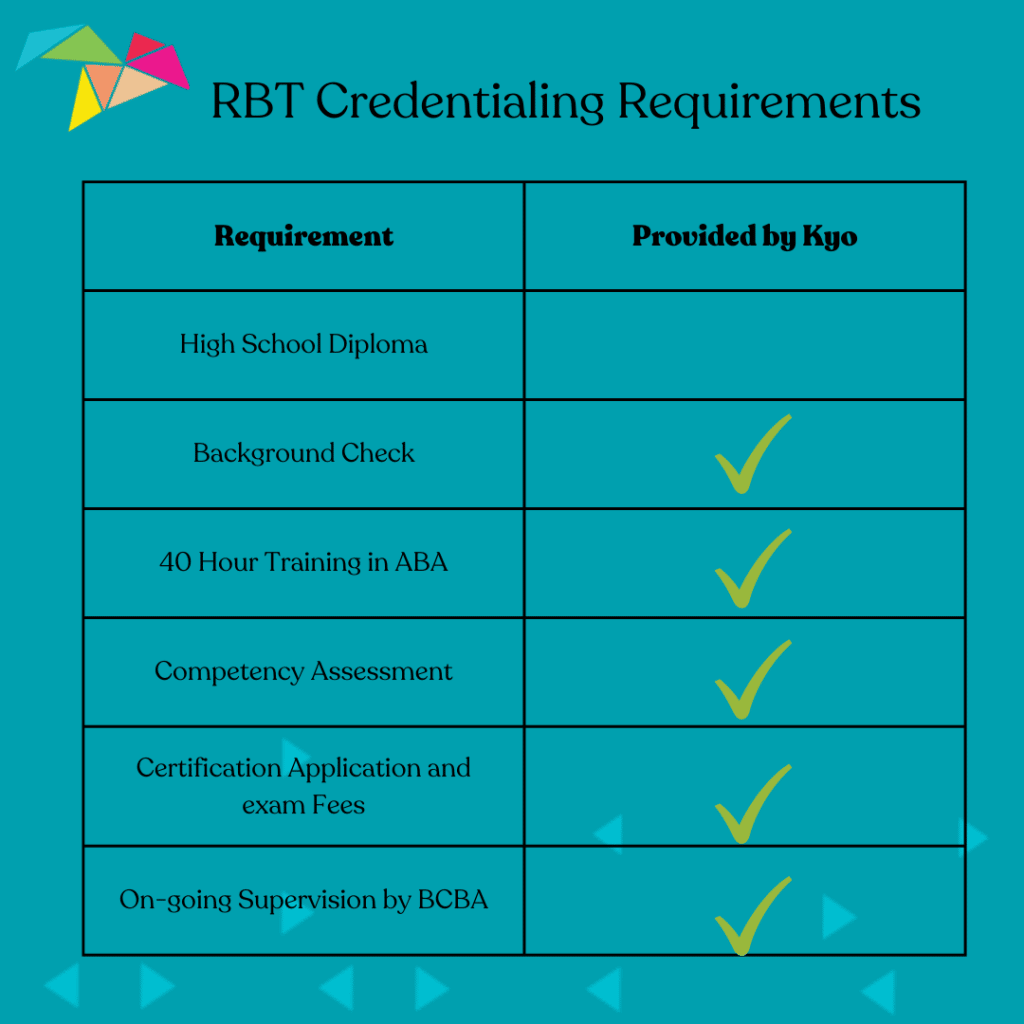
Kyo’s Commitment to Behavior Therapists
Working as a Behavior Therapist is a fun and rewarding job, and like any job, it also has challenges. At Kyo, we support our Behavior Therapists through mentorship, regular clinical supervision, and opportunities to grow within the field of ABA. Start a career in ABA today! Apply here
Learn more by reading a first hand account from one of our behavior therapists.
If you are looking for information on how ABA strategies are used visit our Youtube channel.
Transitioning back to school after summer break is exciting, but it can also be pretty overwhelming. Approaching the transition as a great time to establish new routines and teach your child new skills is one way to provide structure and a sense of control over what can be a stressful time. To help guide you through this process, we’ve put together our top 7 tips for ensuring a smooth back-to-school transition.
1. Re-establish morning and bedtime routines
Families’ schedules often change when kids go back to school. In the weeks leading up to the first day of school, start to gradually re-establish your typical morning and bedtime routines for the school year. For example, have your child go to bed or wake up a half an hour earlier every few days, until they are waking up and going to bed at their typical times for the school year.
2. Priming
Priming is the process of helping an individual to prepare for a change or an event by providing information before the event occurs. When priming your child for the transition back to school, consider which significant changes may be challenging for your child, and have them problem-solve with you. For example, if your child will be going to a new school, you may want to plan a few trips to the school over summer to get familiar with the campus. You could also review the school’s website with your child, looking at pictures of their new teacher, the principal, support staff, and office staff.
3. Involve your child in gathering school supplies
If your child is apprehensive about returning to school, focusing on gathering school supplies can build anticipation and a positive association with going back to school. If your child needs a new lunch box, water bottle, or clothes, involve them in choosing their items, so they are excited to use them. Even if you’re not buying new supplies, you can still build this kind of anticipation by having your child clean, decorate, or spruce up their existing supplies. For example, adding some fun stickers to their water bottle, sharpening their favorite glittery pencils, or picking out some supplies to give their teacher on the first day can be fun, creative ways to get them excited about school.
4. Plan ahead for lunch and snack options
Similar to gathering school supplies, getting some “treats” for school can help get kids excited to go back. When shopping, let them pick out a few special things that you can reserve just for their school snack or lunch. If you are planning on having your child eat the food provided by the school or doing a hybrid of home and school meals, review the cafeteria calendar, and have your child circle the meals they are excited about.
5. Set after school expectations
Work with your child to create and set expectations for their afternoon routines. If your child has a busy afternoon schedule, it can be helpful to set up a visual calendar outlining the details. Draw or write out whether they will be going home or to an after school program, attending extracurricular activities or sports practice. Include info about how they will be getting there and what’s expected of them before they can access play activities.
6. Create Visual Schedules
Visual schedules can be helpful for teaching your child new routines or working on building independence with things they can already do on their own. Create motivation by involving your child in creating these schedules by having them tell you steps, pick images, or color the schedule. For example, your child may benefit from a schedule showing all the steps for getting ready in the morning or a schedule showing just the steps of getting dressed.
7. Use checklists
Once your child is used to their routines and schedules and has developed some independent skills, you can have them start to do some self-monitoring through the use of checklists. Modify existing visual schedules or create new checklists for specific ways in which you would like your child to be more independent. For example, a checklist for all of the things they need to remember to put in their backpack every morning, or a checklist for completing homework when they get home can help them complete those tasks independently.
Download our free printable back to school resources.
If you are looking for information on how ABA strategies are used visit our Youtube channel.
You can also find more articles on a variety of ABA strategies here.
Applied Behavior Analysis (ABA) therapy is a growing and rewarding field, with job skills that are highly transferable to other industries.
ABA uses the science of human behavior and principles of operant conditioning to shape behaviors over time. Once you start knowing what to look for, you can see the principles of ABA in effect EVERYWHERE in your daily life. That fitness tracker on your wrist; the points you earn from your credit card company; that annoying dinging noise when you don’t put your seatbelt on in your car – they are all shaping your behavior using the same strategies used in ABA therapy.
The professionals who work in the ABA field include researchers, physicians, and licensed clinicians, who work with children with developmental disabilities. An entry-level staff person in this field is generally called a behavior therapist or behavior technician (BT). Board Certified Behavior Analysts (BCBAs) create and manage client programs and supervise BTs.
As published by the BACB, In 2012, there were 10,368 BCBAs in the United States; as of 2022, there are 54,223. That’s an 18% annual growth rate!
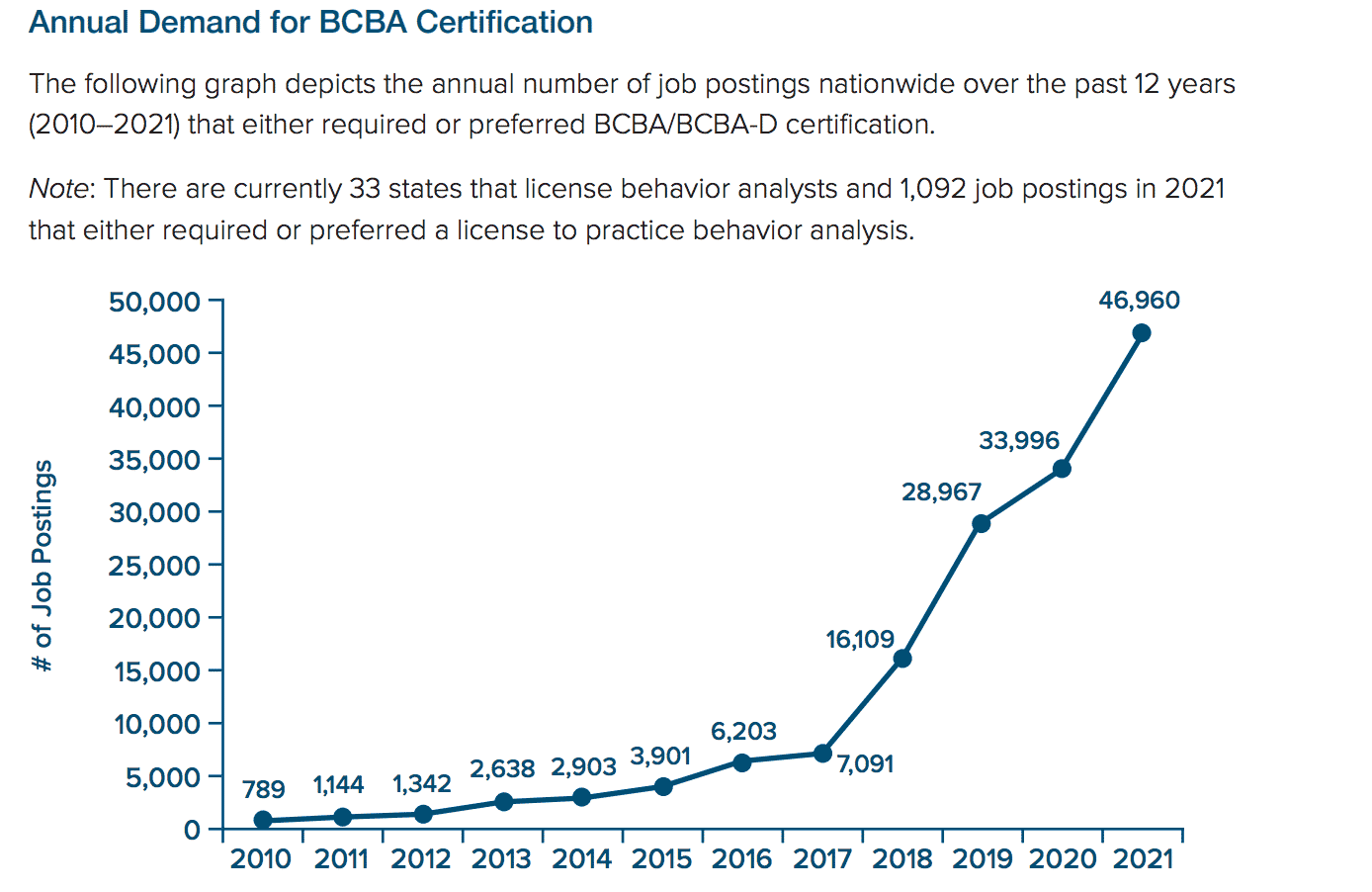
As the field of ABA grows, there has also been an increased demand for skilled BTs, who work one-on-one with children with developmental disabilities. In 2013, the BACB (Behavior Analyst Certification Board) created the Registered Behavior Technician (RBT) credential, to create a standardized set of requirements and guidelines for individuals working directly with clients. Due to the high need for RBT providers, many ABA agencies will provide new employees with the required training, BCBA oversight, and compensation for acquiring an RBT credential.
An Expanding Field
Once credentialed, the field of ABA offers opportunities for professional growth and geographic flexibility, as all 50 states require some level of insurance coverage for ABA therapy as a treatment for autism. Moreover, the skills acquired working in ABA therapy can be transferred to many other professional job sectors, including education, corrections facilities, sports and fitness, brain injury rehabilitation, corporate training, HR, pediatrics, and the corporate sector.
Voices From the Field
“I started with Kyo in March 2015 as a Behavior Therapist,” says Ellen, a BCBA who leads talent operations at Kyo and began as a member of Kyo’s clinical staff. “My supervisors took the time to get to know me on a personal level, and I quickly fell in love with the impact we were making as a team. I was so inspired by my BCBAs that I started BCBA coursework myself. Since I started at Kyo, I have been a part of the training, recruitment, and regional leadership teams; there has never been stagnation in my professional development.”
In her current role at Kyo, Ellen recruits talented BCBAs and Regional Directors to join our team. She also leads our regional Talent Consultants and supports their efforts to maintain employee morale and performance.
“I have received so much support from Kyo’s leadership team throughout my years here,” Ellen says. “They have encouraged me to take breaks, take time off, and to give myself grace when I fall. This unwavering compassion and support of my well-being has helped mold me into the BCBA and woman I am today. It continues to bring me joy to share this same support and experience with the Kyo team.”
Kyo’s Commitment to Professional Advancement
Kyo is committed to building a workplace that boosts career advancement at all levels. If you’re curious about the growing field of ABA and are looking to expand your knowledge, we encourage you to contact us. We are eager to grow our team with therapists who are curious, compassionate, and humble.
If you are interested in joining our team, apply here.
If you are looking for information on how ABA strategies are used visit our Youtube channel.
You can also find more articles on a variety of ABA strategies here.
Healthcare is one of the most regulated and complex industries in the United States. Agencies that provide ABA therapy as a medical service must take care to remain in compliance with shifting healthcare regulations. To this aim, ABA agency leaders must develop the systems necessary to ensure that staff understand and adhere to local, state, federal, and payor regulations, as the consequences of non-compliance can be severe.
Even the most well-intentioned ABA providers can run into trouble without a thorough compliance program. Compliance with government and payer policies, laws, and regulations reduces the risk of significant fines, disbarment from participation in certain programs, and even jail time. Health Care Fraud is a criminal offense punishable by up to ten years in prison and $250,000 in fines per incident.
In addition to general healthcare regulations, ABA providers face payer requirements and conditions set forth by our field’s certifying Board. ABA agencies may also develop unique internal policy requirements for clinical staff.
To navigate this complex environment, ABA leaders can turn to the U.S. Office of Inspector General (OIG) for compliance guidance and resources. Below are the seven elements needed for an effective compliance program.
The 7 Elements of an Effective Compliance Program
- Designate a Compliance Officer
- Document Policies and Procedures
- Train and Educate Staff
- Develop Effective Lines of Communication
- Develop Internal Monitoring and Audit Processes
- Enforce Standards
- Respond Promptly to Offenses with Corrective Action
As behavior analysts, we can think of the seven elements as proactive and reactive strategies that we can use to reduce the likelihood that our organizations engage in non-compliant behavior. While all of these elements are essential to an effective compliance program, when creating our own compliance program at Kyo, we found that elements 2 and 5 required some additional thought.
-
Designate a Compliance Officer
BCBAs make great Compliance Officers! They are already well-versed in monitoring data and implementing interventions, as needed. Depending on the size of your organization, the role of the Compliance Officer may be part-time or full-time. More time may be needed from your Compliance Officer in the early stages of developing your compliance program than is needed once you are in the maintenance phase. If your Compliance Officer is new to the world of healthcare compliance, consider what training they may need in order to be prepared to undertake their new role. Organizations such as HCCA (Health Care Compliance Association) offer comprehensive training programs, both online and in person, that can be invaluable in preparing your new Compliance Officer for their role.
-
Document Policies and Procedures
Once you’ve identified who will oversee your agency’s compliance program, it is time to start documenting all relevant policies and procedures. You will need to identify what needs to be documented, who the audience is for each policy or procedure, and where this policy will live (a policy that is only accessible to the policy writer does not do much good!).
Consider: What are the federal, state, payer, and organization-level requirements that I expect my employees to comply with? You will need to ensure that your organization has policies and procedures in place to address each of these requirements. For example, if you work with Medicaid patients, you are likely required to train your staff annually in Fraud, Waste, and Abuse detection. Do any of your payers have specific credential or educational requirements of staff? If so, what processes will you set up that will ensure only qualified clinicians are placed with those patients?
If the rules aren’t clear, ask questions and get the answers in writing. Not being aware of a requirement doesn’t absolve you from being expected to follow it.
-
Train and Educate Staff
It’s your responsibility to explain compliance requirements to your employees and make sure you’ve trained them in ways that enable them to comply with requirements. Depending on the nature of the requirement, you may need to provide training upon hire, annually, or perhaps even more frequently. In today’s virtual world, pre-recorded training videos are relied upon heavily and can be useful. However, live trainings that allow for Q&A may lead to a greater understanding of the policies or processes being disseminated.
Maintain detailed training records for every employee; you never know when you will be asked to produce proof that someone has completed a required training.
-
Develop Effective Lines of Communication
It is crucial that staff know where to go to get their questions answered, as well as whom to approach with compliance related concerns. Employees should understand that they face no retaliation for escalating a concern about compliance within your organization. At Kyo, we have found it helpful to set up a third-party hotline that allows employees to anonymously report any compliance concerns.
-
Conduct Internal Monitoring
In addition to creating policy documents and training your staff, regular internal monitoring is essential to identify instances of non-compliance and to determine when and for whom re-training is required. Consider a BCBA who works with four different payers, eight different behavior therapists, and 15 clients. They are likely to be responsible for overseeing 75 or more billable events per week, which have the capacity for thousands of potential rule violations!
Given the number of policies your agency has established, it is probably not realistic to expect that you will be able to set up robust monitoring systems for every single policy and procedure. You will need to decide which ones to prioritize for monitoring and balance that with the amount of effort and cost involved. Determining which policies have the highest risk to your company when it comes to non-compliance may help you to decide where to start.
At Kyo, we have leveraged technology to set up automated monitoring systems wherever possible. Things like code usage, supervision ratios, and upcoming certification expirations can all be monitored automatically, allowing whomever is doing the monitoring to quickly identify areas of concern, without having to manually dig through hundreds of billing entries.
While we have been able to create many automatic monitoring systems, we have found that there are some clinical elements that still require manual monitoring, including treatment plan content and clinical note content. An automated system cannot replace an experienced BCBA reviewing the clinical quality of these documents and ensuring that required components are included. However, depending on the size of your organization, it likely may not be realistic to have 100% of clinical documentation monitored. Focusing your time and attention on the documentation produced by new clinicians and clinicians who have previously been found to be deficient allows you to hone in on areas of high potential risk. Add to that a monthly review of a percentage of randomly selected clinical documents, and you will create an effective clinical note monitoring system.
-
Enforce Standards
Hopefully, setting up robust documentation and training programs will lead to an extremely compliant organization! It’s important to make employees aware of the potential repercussions of non-compliance and to apply compliance standards uniformly across your organization.
-
Respond Promptly to Offenses with Corrective Actions
Remember those effective lines of communication that were developed in element 4? When employees report concerns, it’s critical to take timely and appropriate follow-up action. Be prepared to take quick action when monitoring or auditing programs uncover potential healthcare compliance issues.
Main Takeaways
While the idea of setting up a robust compliance program for your ABA agency may feel overwhelming, it is well worth it in the long run. Healthcare compliance is such a serious matter that even accidental oversights can be financially devastating for a company. By dedicating some time and resources towards designing a compliance program that meets the 7 elements outlined above, your agency will gain a level of protection that will be beneficial for years to come.
To hear more about Kyo’s healthcare compliance program from its creators watch the full webinar on Youtube.
If you are interested in joining our team, apply here.
You can also find more articles on a variety of ABA strategies here.
Structuring Playtime with Toys and Objects
Letting your child initiate and direct play helps them to connect with you and other family members. To get started, watch your child as they approach a shelf or other area that has several toys. Which toy or other object do they reach for? Let that toy or other object be the focus of your play for the next 5, 10, or 15 minutes, until your child is showing signs that they are bored or signs that they are more interested in a different activity.
As your child gravitates towards a toy, name it. For example, if your child approaches a container of bubbles, you might say, “Oh, you want bubbles!” Blow a few bubbles and allow your child to pop or chase them. When the bubbles have popped, pause and wait for your child to initiate wanting more. This might look like eye contact, pointing, exchanging a picture of the item, sign language, or them trying to say an approximation for “bubbles”.
Hold onto the container of the bubbles, so that your child is motivated to connect with you in order for you to make more bubbles appear. For as long as your child remains motivated, you can use the bubbles to extend your child’s language and imitation skills. What are some fun, silly things that you can do with bubbles? Could you model catching them on a spoon? How about blowing them up high or down low? Each time you change the activity with the item, you create an opportunity to practice new skills, such as requesting “high” or “low” or imitating actions with the object.
Connecting through Activity-Based Play
Not all play requires toys or objects. Think about games that you played as a young child – Ring Around the Rosy and Peek-A-Boo are a couple of examples of interactive games that require no objects. These activities, which require multiple people and build excitement off of anticipating the next step, offer wonderful opportunities for building a child’s shared attention, language, and imitation skills.
Let’s take “Ring Around the Rosy” as an example. The first time you play this game with your child, go through the full round of singing/movements. The next time, pause expectantly at various times and wait for your child to look at you before you continue to move/sing. If your child is learning to talk, you might pause until they vocalize an approximation for the next word. You might sing “Ring around the ____” and wait until your child makes an attempt at saying “Rosy”. As soon as they make an attempt, continue to sing/move in an animated way. You can try going slower or faster with this activity, providing your child with the opportunity to request slow or fast.
You might also try making up a movement routine. For instance, if you are standing in your living room, and your child starts to jump, you might imitate your child jumping. This may get your child’s attention. Once you have their attention, change your movement to encourage them to copy you. For instance, you might start to turn in a circle or reach up to the sky.
Takeaways
Playtime offers rich opportunities for building a child’s communication and social skills. Think about games, songs, and toys you loved as a child and see if you can introduce a few of them with your own little one as a way to build their skills. When you approach play as an enjoyable way to help your child learn and use new words and actions, you’ll likely find yourself as engaged and excited about playing as your child is!
Download our free printable toddler communication resource guide.
If you are looking for more quick tips on how to use ABA strategies at home visit our Youtube channel.
You can also find more articles on a variety of ABA strategies here.
Using Token Systems to Reinforce Positive Behavior
We launched this series to help parents understand why children engage in challenging behavior and to offer practical strategies for promoting positive behavior. One such strategy is the use of a token system. A token system is a handy tool that you can use to encourage a behavior that you want to see your child exhibit more often.
Token Reinforcement Systems
A token system involves giving a child points, stickers, or small objects (aka tokens) for specific behaviors that you want to see occur more frequently. The child saves up and trades in a predetermined number of tokens at a later time for an object or activity that they want. Sometimes, a child may trade in tokens a few minutes after starting to earn the first one; other times, the delay may be several hours or several days. This depends on your child’s learning stage.
Some classic examples of token systems are:
- earning points
- raffle tickets
- sticker charts
- marble jars
- unifix cubes
- money
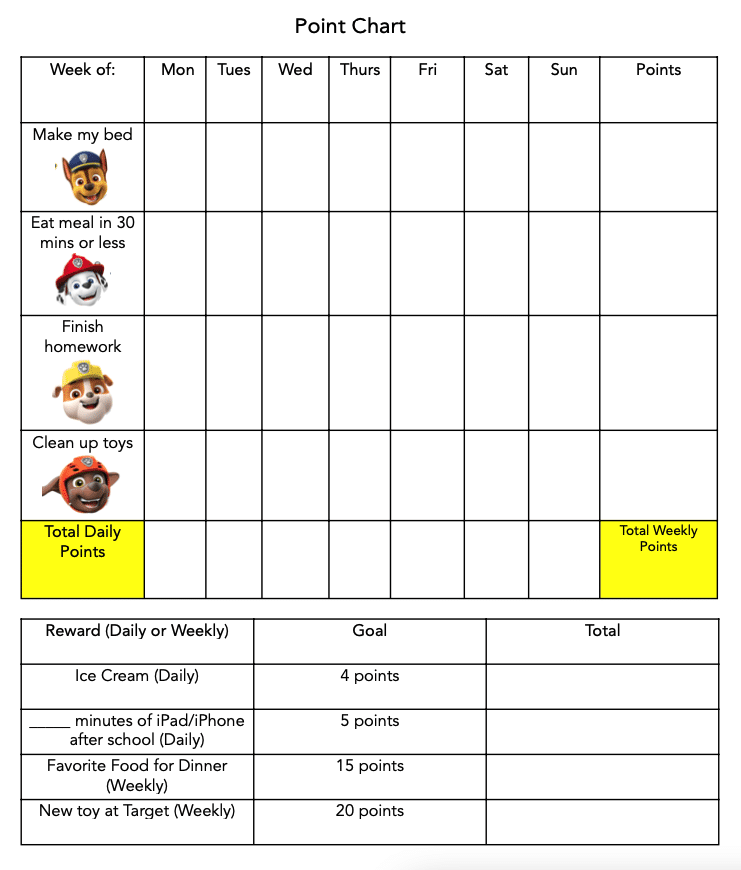
For a token system to be successful, be sure to:
- Determine a clear behavior that you want to reinforce
- Decide how often you’ll provide reinforcement
- Figure out what your child is motivated to work for
- Decide what you’ll use as tokens
- Explain the plan to your child
Here are a few examples of ways that parents can use token systems.
Dylan knows that if he doesn’t interrupt his mom when she talks to her friend Erin, he will earn a token for every minute his mom is on the phone and he is patient. Over time, Dylan’s mom is able to increase Dylan’s wait time, offering a token every couple of minutes, rather than every minute. At the end of the phone conversation, Dylan trades in his tokens for access to a special toy.
Drew’s dad has been looking for ways to increase Drew’s activity levels, including participation in family walks, which they typically protest. When Drew comes on the family walk, they earn a token for each block they walk without protesting.
Ella’s parents give her a star token for every evening she uses calm words to ask for what she wants, or to express her feelings without screaming. After earning five star tokens, Ella gets to pick out a movie for the family to watch together.
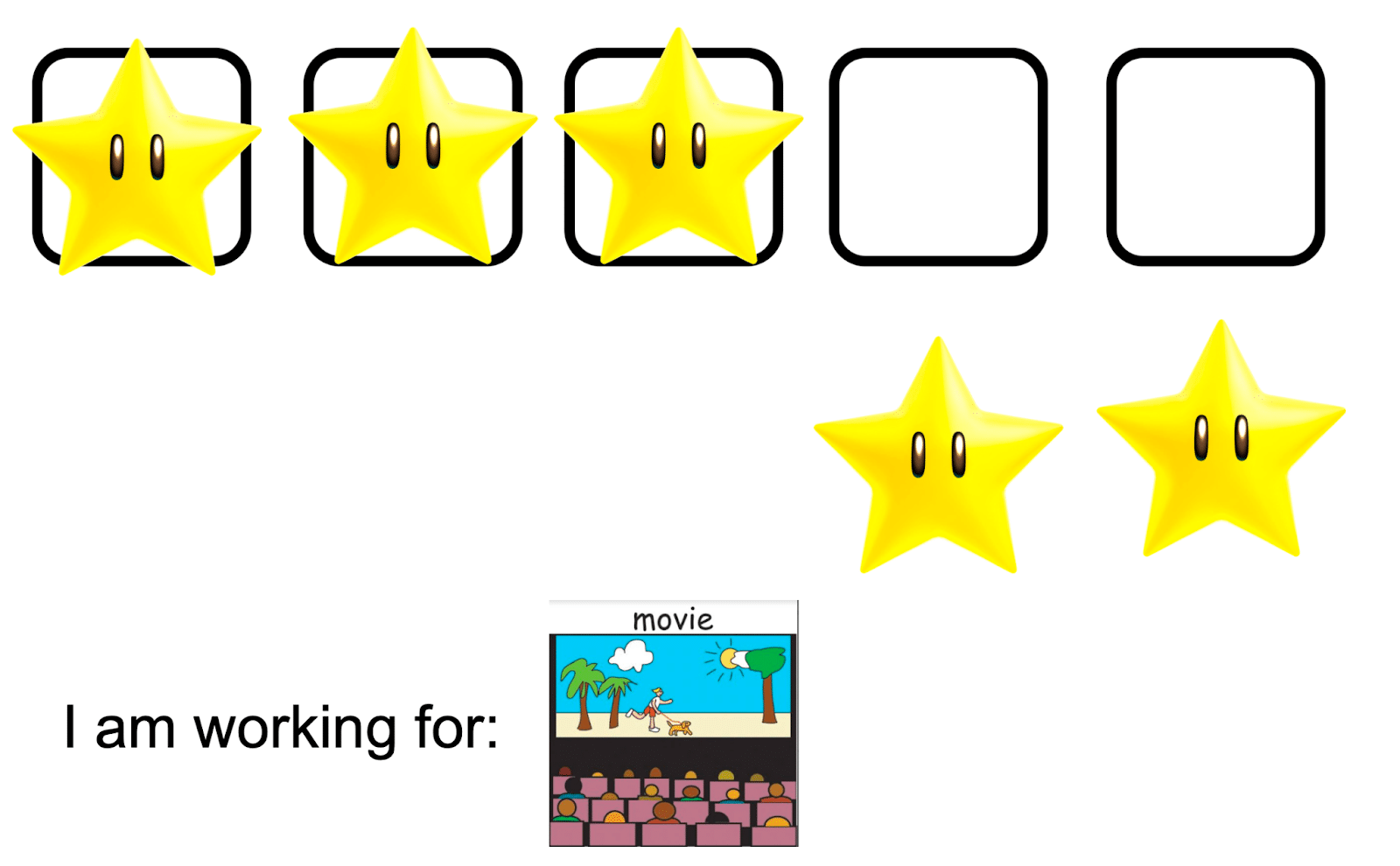
Tokens can be very useful in teaching new skills and can quite easily be faded over time. Just because you offer tokens initially to teach a skill or increase a behavior doesn’t mean that you will be stuck offering tokens forever! Eventually your child will develop independence.
Tokens can be initially offered for each bite of vegetables, every minute of sitting calmly, or every time you see your child being kind to a sibling or pet.
We recommend being really specific to start. Begin with a short time frame and give tokens frequently, rewarding even small efforts on your child’s part.
Over time, you can increase the amount of work required to earn a token, as well as the number of tokens required to earn the reward. You can stick to short and sweet time frames or extend your timeline to last for days or weeks before the child earns a reward.
One side benefit of extending your timeframe: It can ultimately help children who expect immediate reinforcement to increase their delay tolerance. This system works well for both younger and older children, as long as your child is able to understand why they’re getting tokens and the concept of trading them in for a reward.
Cultivating Positive Behavior Over Time
Token systems increase motivation by providing periodic reinforcement and can help children develop their ability to delay gratification over time. They are versatile and can be tailored to your child’s age and behavior goals. Remember to be patient with yourself and generous with your positive rewards, including praise, as you use token systems. They’re just one of many tools available to help cultivate good behavior in your child.
Download a free printable token economy here.
If you are looking for more quick tips on how to use ABA strategies at home visit our Youtube channel.
You can also find more articles on a variety of ABA strategies here.
When you create communication and learning opportunities as you go about your normal daily routine, you help your child learn, practice, and generalize skills. As discussed in our previous post, arranging the environment in a structured way increases your child’s motivation to communicate. Mealtimes offer wonderful opportunities to work on teaching language as there is inherent structure and motivation already ingrained in the activity. If it feels too overwhelming to turn every meal into an instructional activity, start with just one meal a day.
Teaching and Shaping Requests
One easy way to create mealtime learning opportunities, increase motivation and create more practice opportunities is to offer small portions of the meal with pauses in between offerings to elicit communication. Using clear containers can be helpful for this, so that your child can see the food but will need to communicate for more. For example, if your child really enjoys blueberries, give them a bowl with three or four berries and put the rest of the berries in a clear container with a lid. Each time they finish their berries and want more, they will have an opportunity to learn how to make a verbal request.
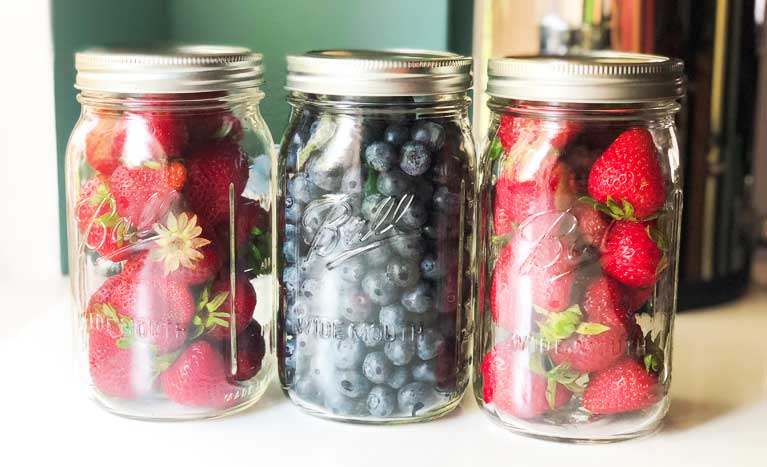
You can model the word you are teaching while giving them more, in this example saying “berry” or “blueberry” as you put a couple more in their bowl. After modeling this a few times, purposefully pause while holding out the berries to give your child an opportunity to make a request.
Initially, you might reinforce your child looking at you by giving them more berries. This is helpful if you are trying to teach your child to make eye contact with others more frequently. Next, you might hold out until your child makes a sound – any babbling sound that is not a cry or protest. You might revert back to modeling the target sound word “berry,” while delivering a few more before pausing purposefully again. Gradually, you will offer the blueberry for closer and closer approximations of the word.
Generalizing and Expanding
As your child starts making requests and acquiring more language, you can use mealtimes to work on expanding their vocabulary. For example if your child can name most food items in their regular diet, you can start working on adding descriptors to requests. Many foods come in different colors, so this can be a great place to start. If your child requests an apple, hold a green apple in one hand and a red apple in the other. While showing them each apple, ask “do you want a green apple (put out hand with green apple) or red apple (put out hand with red apple)?”

Follow the same strategy as before, reinforcing closer and closer approximations until they can provide the full request without help. Provide reinforcement by giving them slices or chunks of the color apple they chose. You can use the same teaching process to expand your child’s vocabulary to include other descriptors such as shapes (round cracker or square cracker), numbers (1 cheese stick or 2 cheese sticks) and size (small carrot or big carrot).
Another way to create mealtime learning opportunities is by thinking about what other things your child may need in order to eat their meal and intentionally leaving some of them out. For example, giving them yogurt but no spoon or cereal but no milk. Similarly you can give your child foods in closed containers or packages that they can’t open. Then wait to see if they try to request for “open” or “help”. If they don’t make a request, you can give a suggestive prompt such as “hmmm, what do you need?” Then provide them with a model and reinforce their attempt at a request by opening the food. You can also give them un-peeled or uncut items to encourage them to request for “open” “cut” or “help”.
Takeaways
There are so many ways to help your child advance their language skills from the comforts of home during mealtimes. Stay tuned for more ideas to help young children with special needs connect and communicate.
Download free printable feeding resources.
Download our free printable toddler communication resource guide.
If you are looking for more quick tips on how to use ABA strategies at home visit our Youtube channel.
You can also find more articles on a variety of ABA strategies here.
In this series, we began by sharing ways to figure out the motivations behind your child’s behavior. Then, we offered some strategies we’ve found effective for dealing with the behavior itself—including preventing it in the first place. The “First/Then” approach, known in the child development world as the Premack Principle is an effective way to motivate kids to engage in activities they’d rather not do, such as washing their hands or completing homework assignments.
The First/Then Approach
According to child development experts, it’s possible to motivate your child to do an activity they don’t like very much, as long as they know they can do something they love afterwards. You can use “First/Then” statements to tee up a reward to encourage children.
For example, if a child knows they have to complete their homework before they can play at the park, that can motivate them to get the homework done efficiently. You can say, “First, do your homework; then, you can play at the park.”
Other examples include: “When you have finished your math worksheets, you can play video games.”; “First, come on a walk with us; then you can watch TV.”; and the tried and true: “First, finish your dinner, and then you may have dessert.”
Boost the Effectiveness of First/Then Statements
A few things to know about this approach: It’s most useful for tasks that have a clear beginning and end, like nightly homework, a walk, or a meal (versus a long-term school project or preparation for a piano recital).
Another tip: Try different formats. Our examples thus far have been verbal statements, but what about trying a visual? You could use a whiteboard, photos, or even a “house rules” poster.

When there’s an activity on the schedule that’s not a favorite, you can set a timer for it and offer a favorite activity right afterwards. For example, if your child needs to do a school assignment and is feeling reluctant, you could set a 15-minute timer and let them read a favorite book after they’ve worked intently for 15 minutes.
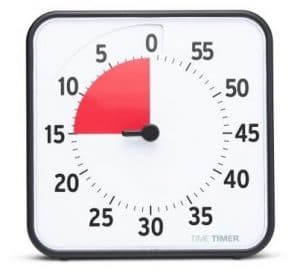
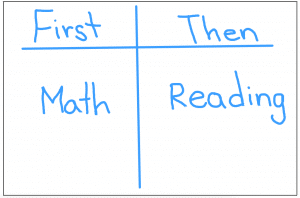
You can also increase buy-in by having your child help to select the activities. This combines the power of the Premack Principle with the power of offering choices. For instance, if you’re trying to increase your child’s repertoire of play activities, offer a choice of the “First” activities. These may be toys or play activities that your child does not yet seek out independently (e.g., legos or puzzles). Also offer a choice for the preferred play activity that will be available afterwards (e.g., Playdoh or painting). Some children may benefit from having the selection process be physically interactive. Your child could select and place the objects left to right on a table, or they could select photos or other picture presentations of the activities and place them on a “First/Then” board.
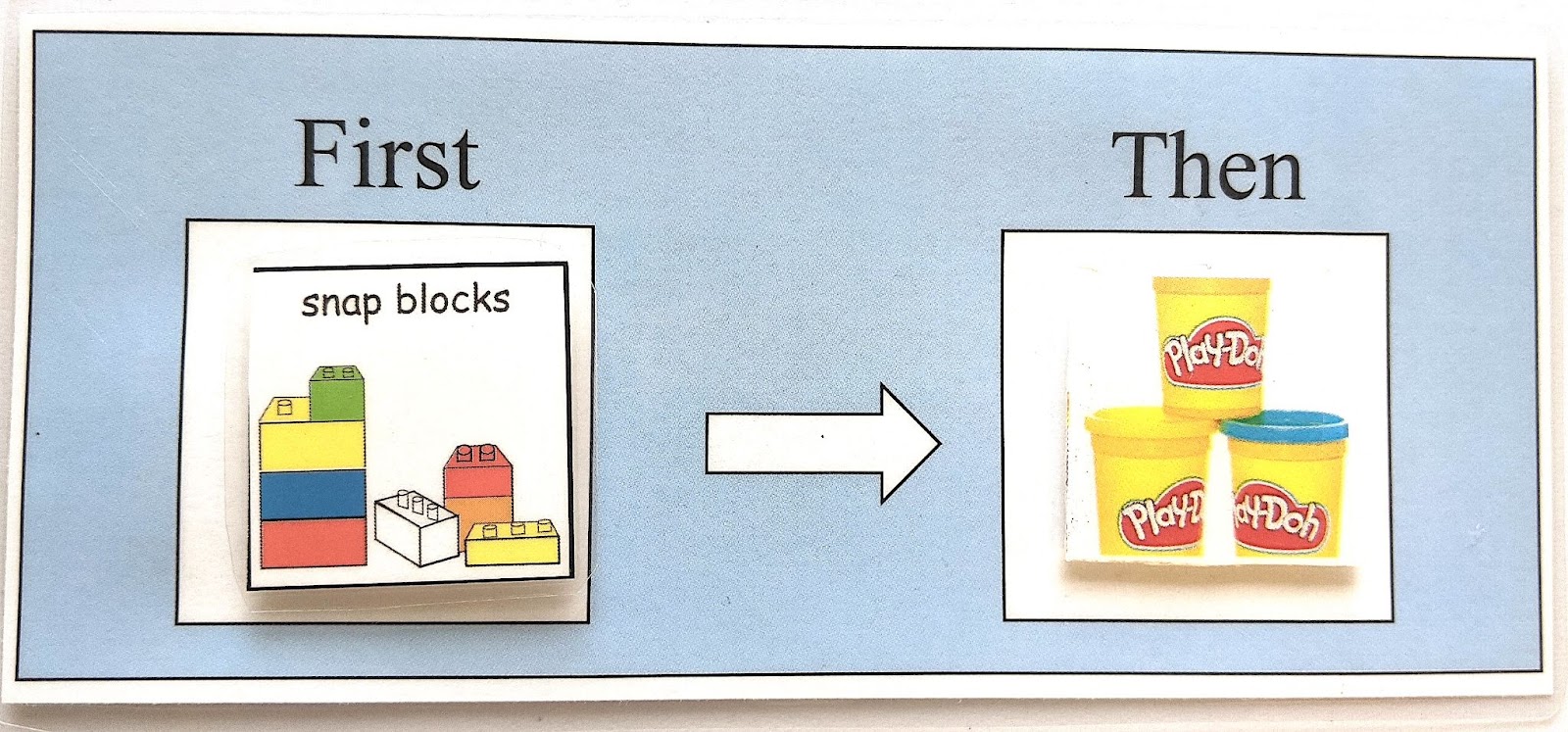
Main Takeaways
The First/Then approach is a structured way to help children who resist completing certain tasks get through them, often happily. It’s easy to implement and effective. In our next post, we’ll talk about another constructive way to tackle challenging behavior.
Download free printable visual strategies including a first/then board.
If you are looking for more quick tips on how to use ABA strategies at home visit our Youtube channel.
You can also find more articles on a variety of ABA strategies here.
Guided notes are handouts that guide students through a lesson, with background information and visual cues that indicate where they should write key facts, points, and relationships. Similar to choral responding and response cards, guided notes are an Applied Behavioral Analysis (ABA) technique that allows an entire class of students to respond to questions or prompts simultaneously.
How Guided Notes Work
When taking guided notes, students fill out thinking pages and study aids to support learning.
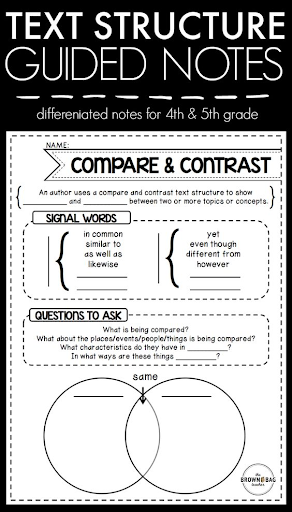
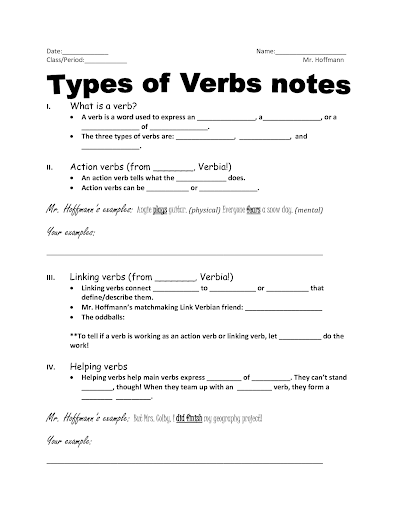
Guided notes provide students structure to help them listen, attend, and capture relevant information during a lecture or video. On the continuum of teacher effort and preparedness we’ve been referencing in our posts about ABA techniques in the classroom, this strategy probably requires the most effort on the part of both teacher and student, but the results justify the effort.
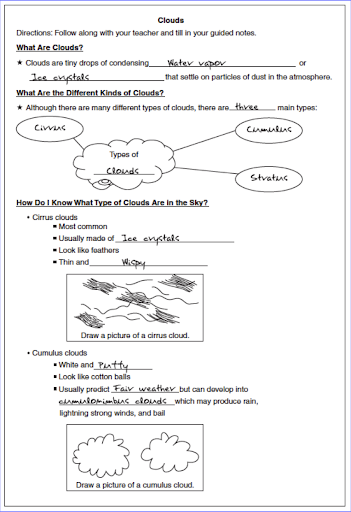
Guided notes provide structure, with critical information left out, to encourage students to listen, think, and follow along. Teachers can pause, prompt, and encourage students to fill out their notes as the lesson progresses.

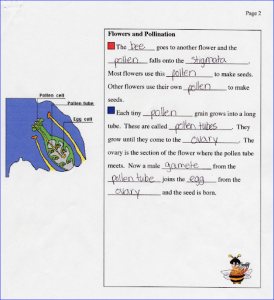
Students can use guided notes to follow along with a lecture, video or lesson. They can be used for any curriculum area, subject, or grade level. They can be used to highlight and think critically about key concepts. They’re available for later study and review. They can be used to teach note-taking skills.
Guided notes can be simple, but they can also increase in complexity. They are most useful to students when the teacher has carefully prepared the lesson and the corresponding notes. They are most effective in classrooms in which the students are likely to stay on task with the lesson. And they’re worth the effort: Research shows that students at all achievement levels earn higher scores on quizzes and tests that cover curriculum content taught with guided notes, compared to the scores earned when students take their own notes (Konrad, Joseph, Eveleigh, 2009).
Tips for Using Guided Notes Effectively
There are several key aspects of guided notes that make them more impactful than students’ own notes. Teachers can incorporate these best practices into their lessons and the notes themselves, to help ensure optimal outcomes from the use of guided notes
- Provide background information, so students’ note-taking focuses on important facts, concepts, and relationships.
- Use consistent visual cues that show where, when, and how many concepts to record.
- Make sure the notes include all facts, concepts, and relationships that students are expected to learn.
- Don’t require students to write too much.
- Review notes for accuracy before students use them to study. The teacher can review each students’ notes, followed by a student self-check of the notes and a peer review.
- Build in follow-up activities and contingencies for students’ completion and study of the notes.
Benefits
Research shows that guided notes help a variety of learners. Not only can they result in improved quiz and test scores, compared to students’ own notes, they help all students understand exactly what they should be learning and whether or not they’ve got it. Students are better able to determine whether they’re understanding the curriculum, because key facts, concepts, and relationships are highlighted. And the fact that students produce a standard set of accurate notes for subsequent study that can be reviewed by the teachers, self-checked, and peer reviewed allows for review of the material that is focused on what’s most important.
Guided notes are just one more technique that encourages Active Student Responding. We know that more opportunities for students to respond during class result in more engaged learning. ASR techniques provide opportunities for fun, quick, informal formative assessments and observational and peer learning. Students enjoy them, and so do teachers.
If you’re interested in trying some of the other techniques covered in this blog post series, below are some links to digital tools you can use to try ABA techniques with your own students. For example, Formative is a live active digital tool that can tell you how your students are responding to your lesson in real time.
Additional Resources
- Guided Notes Maker
- Response cards – Quiz and Poll Creators Curated by Janet Twyman
- Enhancing Engagement – Article by Matt Tincani and Janet Twyman
- How to improve student learning in every classroom now – Article by Janet Twyman and William Heward.
- Digital behavior management tools:
We hope that you’ve enjoyed our series highlighting ABA tactics in classroom settings!
If you are looking for more quick tips on how to use ABA strategies at home visit our Youtube channel.
You can also find more articles on a variety of ABA strategies here.
Response cards are cards, signs, or other items all students in a class hold up simultaneously to display their responses to questions or problems presented by the teacher. Like choral responding, response cards are an Applied Behavioral Analysis (ABA) technique that can be used in the classroom to encourage the whole class to respond to questions together. It’s more effective than traditional hand-raising, with one student at a time called upon to respond, which really only tells the teacher that one student understands the material. Response cards allow the entire class to engage with the material and demonstrate their knowledge.
“I loved using response cards in my classroom, especially when I taught students who were more moderately to severely impacted with autism in a special day class setting in San Francisco,” says Kyo Chief Clinical Officer Melissa Willa. “Response cards can be highly engaging for kids and increase active participation in lessons.”
Using response cards
The main goal of response cards is to increase the number of times throughout the day when an entire classroom of students can engage and respond and demonstrate what they’ve learned. For example, many classes begin the day with some words on the board, and one student is called upon to help fill in the blanks. What if all the students got to participate?
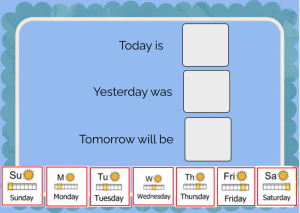

Response cards could allow all students to let the teacher know what day it is, what the weather is like, etc. Response cards also enable greater inclusivity of nonvocal or nonverbal students, who can raise a card for the answer and participate with the entire class.
Response cards can be used for a variety of lessons, including multiple choice, true/false, or yes/no questions.
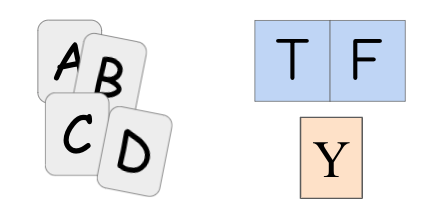
Each student could hold cards labeled A, B, C, and D, and when a teacher quizzes them, they could hold up the card they believe corresponds to the multiple choice answer.
They might each have a True and a False card, and hold them up to show their answer.
For example, if the teacher says, “The Declaration of Independence was signed in 1776,” students could hold up “True” or “False.” Once everyone in the class knows that the answer is, in fact, “True,” they can practice holding up the “True” card all together to answer the question.
Or, they might each have a Yes card that they hold up when they think the answer to the teacher’s question is Yes.
Other cards could be made to look like different flags for a lesson on the American Revolution.
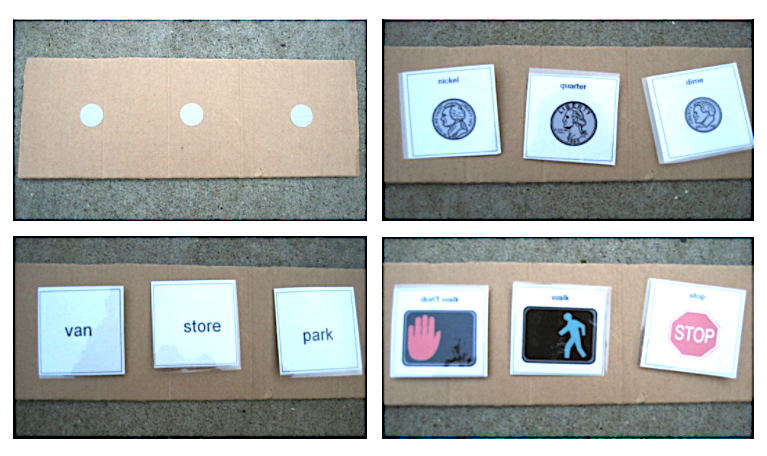
One low-tech, low-budget example of how you might incorporate response tools, like cards, in your classroom is to cut a cardboard box into strips and attach velcro dots, then make laminated cards with velcro on the back. Each student receives a cardboard strip and a set of cards. Students place their cards on their board, creating an array. The cards might depict colors, shapes, numbers, letters, or sight words. For example, a teacher who wishes to provide practice on sight word identification might distribute sets of sight words and then ask students to locate and hold up specific words, like “stop” and “exit”.
Students can also manipulate velcro cards to show the order in which events took place in a story.

Another way to use response cards could be to create a laminated chart with, “First, next, last” written in columns and pre-created laminated images. The teacher could use it to check for understanding after reading a story to the class. What happened first in the story? Students could choose an icon that represents what happened first, next, and so on.
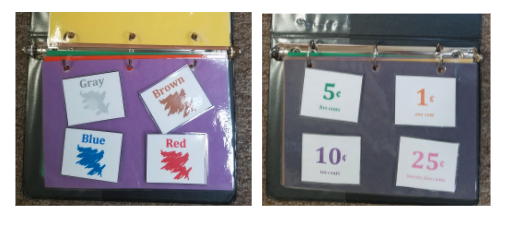
Bondy and Ticani (2018) wrote about how primary school aged children with autism and intellectual disabilities used response cards. Their article, “Effects of Response Cards on Students with Autism Spectrum Disorder or Intellectual Disability,” showed the effectiveness of response cards in increasing student participation and correct responding.
Tips for using response cards:
- Encourage students to keep cards facing the teacher.
- Prompt students who seem to need it and remember that they will learn from that and from following peers.
- Use response cards to modify instruction: What a student holds up lets you know whether they understand the concepts or not.
- Provide immediate feedback: Let them know they’re correct.
Response cards do take effort and time to create, so if you’re looking for a slightly simpler solution, a second option is a whiteboard or a laminated card. Students can write their answers on the whiteboard or laminated card and erase them in between questions or topics. Many schools used this method during virtual learning. It’s lower effort than creating response cards for an entire classroom, and it delivers great results.
Main takeaways
The primary goal with response cards is to increase the number of times throughout a day when an entire classroom of students can engage and respond and demonstrate what they’ve learned. ABA is often thought of as a teaching method delivered 1:1 for children with autism, and to date, that is its most common format. However, ABA techniques can be applied in group settings to reach many more students. The results are all positive: increased participation, decreased challenging behaviors, and higher student achievement.
If you are looking for more quick tips on how to use ABA strategies at home visit our Youtube channel.
You can also find more articles on a variety of ABA strategies here.
In our series of stories about ABA techniques that increase student response time and engagement, we’re sharing three effective teaching methods that increase student participation. To engage more students, we need to implement teaching techniques that encourage active student responses. In choral responding, students respond orally in unison to each question, problem, or item the instructor presents.
Choral responding can be used for:
- Math: number identification, basic facts
- Reading: letter, word identification
- Social Studies: geographic identification, vocabulary
How to teach using choral responding
Choral responding works particularly well when the responses are short, one-word responses with key similarities. Remember to allow students time to think. You can signal for thinking time by putting one hand up or making a specific sign for your students. When you’re ready for students to respond, provide a signal, like lowering your hands, or a tap on an item, that cues them to respond in unison.
In the skeleton example below, students could first learn the names of bones with the names showing, then practice with them removed. You can state the question or prompt, pause for thinking time, and signal students to respond by tapping or touching the bone.

For example, the teacher could say, “This is the skull. What is it?”
Students would respond in unison: “Skull.”
The teacher could continue by saying, “The human brain is inside the skull. What is this?”
Students would respond in unison: “Skull.”
Language Arts often has word lists, and choral responding offers a flexible way to practice vocabulary as a class.
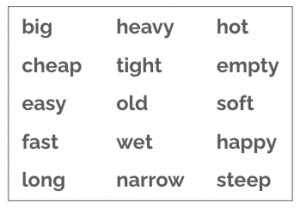
You could teach students the words on the list and then begin choral responding.
The teacher could say, “This word is ‘cat.’”
“What is this word?”
The teacher taps the word, cueing students to respond.
The students respond, in unison, “cat.”
The teacher could ask students to read the words horizontally or vertically, say the opposite of each word listed, name the words in alphabetical order, or name words that rhyme.
The teacher could ask, “What word rhymes with hat?”
The teacher could tap the word “cat,” and the students could say it in unison.
The teacher could say, “This word is ‘big.’”
Then the teacher could ask, “What is this word’s opposite?”
The teacher taps the word, cueing students to respond.
The students respond, in unison, “Small”.
Tips for using choral responding in a lesson:
- Provide a lively pace.
- Provide confirmation and praise when the whole group answers correctly.
- Alternate between individual and smaller group responses. This allows individual kids to be successful in front of the whole group because they just heard the answer.
- Model new material and responses before asking students to respond.
Choral responding: low effort, high impact

Of the three techniques we’re talking about in this series, choral responding is the easiest to implement, with the highest impact, across all types of curriculum. Choral responding can be used in multiple settings and formats, for a range of learners. Research shows that choral responding is an effective way to teach and maintain new skills. We hope you’ll try it in your classrooms and let us know how it goes.
If you are looking for more quick tips on how to use ABA strategies at home visit our Youtube channel.
You can also find more articles on a variety of ABA strategies here.
Kyo Regional Director Nicole Ballinghoff joined the Diverse Thinking Different Learning podcast with Dr. Karen Wilson to discuss how ABA can help kids naturalistically learn skills. In this talk, they discuss how ABA has evolved through the years, the different approaches in the field, and what quality ABA really looks like.
About the Podcast:
The Diverse Thinking and Different Learning Podcast was created by Dr. Karen Wilson, a child neuropsychologist. Her podcast focuses on sharing information about learning differences and interviewing experts who help children and adolescents with learning differences, neurodevelopmental disorders, and social and emotional difficulties. Per Dr. Wilson, the show is designed to educate, inform, and share information, so that parents and educators can be equipped with the knowledge and strategies they need to help students thrive. It is a mix of interviews and solo shows with Dr. Wilson designed to increase awareness of learning and thinking differences and to share information about effective strategies and relevant research.
Listen to the Podcast Here:
https://childnexuspodcast.com/ep-46
Show Notes:
[2:18] – People define treatments in different ways.
[3:05] – ABA is based on the science of learning and behavior. Nicole explains how each behavior is broken down and used in therapy.
[4:18] – ABA uses reinforcement to strengthen skills or teach new skills.
[5:07] – The science has evolved over time. Nicole and Karen discuss what it looked like in its infancy in the 1960s.
[6:24] – There are a lot of different styles of teaching. Nicole describes some different approaches.
[7:09] – What is Nicole’s style at Kyo?
[8:47] – During the school year, a lot of families are reluctant to add on services, but Nicole clarifies that ABA can be implemented in families’ day-to-day lives for additional support.
[10:39] – The family-centered approach has proven to make a big difference.
[11:51] – The Covid-19 pandemic forced ABA therapists to implement creative solutions, and Nicole says she was present for distance learning sessions, if that was what was important for the child and family.
[13:19] – Changing the child is not the goal. The goal is to give children the tools they need to be the best version of themselves.
[14:59] – There is a difference between what is important to the family and what is considered important by society.
[16:31] – If a behavior does not harm a child or their safety, Nicole explains how it may be serving an internal function for the time being and may not need to be addressed.
[19:12] – Whom does ABA serve? It is used in many settings, not just for individuals with autism.
[21:29] – ABA providers are usually covered by insurance.
[22:44] – ABA is not just helpful for children. Nicole also works with teens and adults.
[24:48] – Nicole shares a story of an older child she worked with and how building a relationship is crucial.
[26:56] – Collaborating with the child is important, as well, because some children will know what they want to work on.
[29:38] – Nicole and Karen discuss how being realistic is effective and is an attitude/mindset that the family can implement.
School districts, classroom teachers, and parents are educating more students with autism than ever before: One in 54 students have a diagnosis of Autism Spectrum Disorder, compared to one in 166 in 2004. Educating children with autism requires time and resources; the annual cost of educating students with autism was $268 billion in 2015 and is predicted to be $421 billion by 2025. Applied Behavioral Analysis (ABA) is the most widely accepted and effective teaching method for students with autism, but because it has most commonly been implemented 1:1, it can be costly. ABA techniques increase effective instruction for all learners and can be used in the classroom with an entire class, or groups of students, and be just as effective as they are 1:1.
Implementing ABA methods in classrooms is a cost-effective way to teach children with autism and their peers. We want to teach administrators, teachers, BCBAS, and parents the principles of ABA in order to bring them to more students. In this four-part blog post series, school and district administrators will learn how to support teachers in utilizing group-based ABA techniques, and teachers and parents will learn how to effectively implement ABA methods in public or private school settings, in order to increase effective instruction for all learners.
In this four-part blog post series, school and district administrators will learn how to support teachers in utilizing group-based ABA techniques, and teachers and parents will learn how to effectively implement ABA methods in public or private school settings.
We’ll share:
- Strategies for group behavior management that set the stage for learning.
- How to use three effective ABA teaching techniques to engage students and support learning.
- How to increase access to ABA teaching methods for all students.
Set the stage for student success:
Best practices for positive classroom behavior
Before we get into specific teaching techniques, it’s important to talk about what type of learning environment is conducive to student engagement.
“When I was in a content specialist role at San Francisco Unified School District, I would get called into classrooms when students were having a really hard time, to help the teacher figure out what changes could be made to help a student,” says Melissa Willa, Kyo’s Chief Clinical Officer, a former elementary school teacher, and leading expert in the field of ABA. “The very first thing I always looked for when I walked into any classroom was a list of rules. Where were they? How were they stated? Was there a system to positively reinforce students for following the rules?”
Think about the environment you want to create at your school and in your classroom (e.g., respectful, informative, helpful) and the behavioral norms you want to support in those spaces (e.g., participate/actively respond when asked, raise hand to be called upon).
Here are some best practices to follow to create those types of environments and behavioral norms:
- Make expectations clear
- Post rules that are easy to see and understand
- Focus on 3-5 rules that are easy to remember
- State rules in positive terms: “Keep hands and feet to yourself”
- Provide practice opportunities for each rule
- Praise students who are behaving appropriately: “I like the way Keisha is sitting quietly, ready to learn.”
- Offer specific praise to reinforce the behaviors you want to see
Strategies to increase student response time
After setting expectations for your learning environment, the next step is to think about how you can maximize students’ opportunities to engage and respond to the material during your available instructional time. In this series of articles, we’ll share three of our favorite methods for increasing student engagement: choral responding, response cards, and guided notes. The idea is to create lessons in which more—ideally all—of students’ time is spent actively engaging with instruction and actively responding to lessons.
Learn more about Kyo’s school support services here.
If you are looking for more quick tips on how to use ABA strategies at home visit our Youtube channel.
You can also find more articles on a variety of ABA strategies here.
Mac and cheese, hot dogs, pizza, repeat. If you’re frustrated by your child’s selective eating habits, you’re not alone. Studies show that picky eating ranges from 14 – 50% of preschool children and 7 – 27% of older children. While many children will outgrow this phase, for some children, picky eating habits persist and become a health concern. Feeding therapists and some speech therapists and ABA therapists have the necessary training to help families to increase the number of healthy foods in a child’s diet. If you are not sure if your child’s fussy eating habits rise to the level of needing a specialist, or if you are on a waitlist for services, there are a few simple steps for introducing new foods that you can take to help your child begin to explore new foods.
In our first post in this series, we offered tips to parents on how to prepare for the process of introducing new foods. In this post, we’ll dive into the actual process of teaching a child to enjoy new foods.
Decide Which New Food to Start With
To start, take out your list of foods that your child loves to eat. Place a star next to a couple of their most highly preferred foods (e.g., berries, popcorn, cookies). These will be used initially as reinforcers to help motivate your child to try new foods.
Next, take out your list of foods that you want your child to start eating. Which of these foods do you think are most critical to your child’s nutrition? Place a star next to a few of these foods.
Which foods do you think are most similar to a food your child already enjoys? Circle those foods. For example, if your child likes apples, they might learn to enjoy a crunchy vegetable like carrots, celery, or jicama, before they enjoy a food that is a different texture, like tomatoes.
Are there any foods that you circled that also have a star, indicating both high nutritional value and similar to a food that your child already enjoys? If so, start with that food!
Introducing The New Food Item
Introduce new food at the start of a meal – it’s when your child is naturally most hungry and most motivated to try something new. Have two plates ready on the table. One plate should hold the food that you are introducing to your child. The second plate should hold the food your child loves that you are using to reinforce your child’s willingness to try something new. Ensure that neither plate is within your child’s reach.
Let’s walk through an example of how you can introduce the new food and reinforce your child’s willingness to try it. We’ll use apples as the preferred food and carrots as the nonpreferred, new food.
Step 1: Present the New Food
To start, place the plate with the new food item (in this case, carrots) on the table in front of your child. Smile, show your excitement, and offer praise and a small amount of the preferred food (e.g., a piece of apple) to your child, simply for tolerating having the plate of the nonpreferred food in front of them. Model eating a small amount of the carrots. Smile and talk about how yummy the food is.
Step 2: Model
Next, model touching a carrot with your finger. Prompt your child to also touch a carrot.
Step 3: Reinforce
Offer praise and a piece of the apple when your child successfully copies you. Next, model touching the carrot to your tongue or model taking a tiny bite of the carrot. Continue the process of offering praise and a small piece of the preferred food each time your child makes new strides towards eating a bite of the new food.
Main Takeaways
The process of introducing new foods can take many days of exposure before a child begins to really enjoy the new food. Expect that it will take at least seven opportunities (days) of having this food introduced before your child tolerates it without your prompting. The reward for your child is a broader palette and additional nutrients, and for you, it’s gradually lowered stress and perhaps less time preparing multiple separate meals.
Download free printable feeding resources.
If you are looking for more quick tips on how to use ABA strategies at home visit our Youtube channel.
You can also find more articles on a variety of ABA strategies here.
Each year, one in four children under the age of five are identified by their family doctors as being “at risk” for developmental delays. Such identifications are made by pediatricians during routine screenings at annual check-ups. Pediatricians and preschool teachers often recommend speech therapy, physical therapy, occupational therapy or ABA therapy (Applied Behavior Analysis) as interventions, depending on a child’s specific needs. But if there’s a wait for these highly sought after services, what should your family do?
Here’s the good news: You are a powerful part of the process. Research has shown that parent-child interactions are an impactful way to help toddlers to connect with others and communicate. In this post we offer some simple strategies to increase your toddler’s communication and language skills at home, in fun, motivating ways, during your daily routine.
Play-based Pivotal Response Training
At Kyo, we like to recommend that families use a method from the ABA therapy field called Pivotal Response Training (PRT) to create motivating learning opportunities at home. PRT focuses on the delivery of natural reinforcement, like making the activity motivating in and of itself, instead of providing unrelated, external reinforcement, like candy. Plus, PRT is often child-initiated, so it’s fun!
PRT was developed by a speech therapist, Dr. Lynn Koegel, and her husband, Robert, both of whom now teach at Stanford University. The goal of PRT is to make broad improvements in a child’s communication, social skills, and behavior, by targeting pivotal areas of a child’s development, like motivation.
Let’s take a look at how we can use PRT techniques to increase your child’s communication during play-time.
How to Motivate Your Child to Communicate:
Set the Stage for Success
Our first tip to increase your toddler’s communication, is to arrange their environment in a structured way that encourages communication. For instance, if your child has immediate access to all of their favorite toys, they won’t have a need to communicate to you when they are wanting to play with a specific toy. While it’s certainly a good idea to have some toys out at all times for your child to seek out independently, it’s also helpful to have some in sight, but out of reach. You might place a few favorite toys on a shelf that your child can see, but not reach. This will provide you with an opportunity to teach your child how to request one of the toys on the shelf.
Depending on your child’s existing communication skills, you might start off by reinforcing eye contact. When your child looks at the shelf of toys and then looks at you, you might look back at them and say in a bright, happy tone, “Oh! It seems like you want something from the shelf. I can help you!” Once your child is successfully making eye contact with you and showing joint attention you might teach your child to request an item from the shelf by handing you a picture of the object or by imitating your vocalization of the name of the object. Reinforce your child’s initial efforts right away, with verbal praise and by retrieving the object and saying something like, “Great job asking for the bubbles!” Eventually you won’t need to praise your child every time they ask for something. The item that your child desires in that moment serves as the natural reinforcer when your child successfully gains access to it.
Offer Choices
You can also encourage your child to choose between items, as a way to increase communication as explained in our earlier post. If your child is hungry and guides you to the refrigerator for a snack, you can provide two snack options and prompt your child to point at their choice, by asking, “Would you like (yogurt or apples) for your snack?”
To facilitate communicating food choices, hold up two snack options in front of your child and teach them to point to the snack that they desire, or velcro pictures of the snacks onto your refrigerator. You can then teach your child to select a corresponding picture of a snack that they desire and hand it to you to communicate what they would like to eat when they are hungry. Teaching a child to communicate with pictures is a wonderful way to bridge the gap when a young child is still learning to talk.
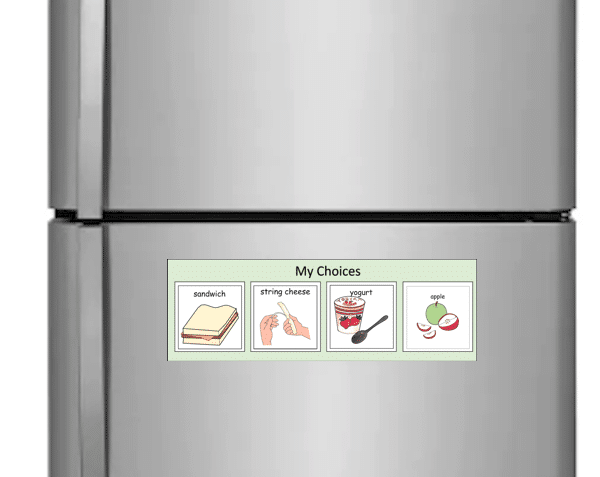
Choices can also be offered during playtime activities as a way to increase your child’s motivation to communicate. Set up an activity that your child enjoys, like a ramp for vehicles to race down. Hold a container of the items necessary to engage in the activity – in this case, vehicles, and present two choices at a time. If your toddler is at the very early stages of socio-communication development, you might start by offering a vehicle when your child looks at the vehicle of their choice and then looks back at you. Next, you might teach your child to point to the vehicle of their choice. For children who have emerging speech, you can model the word “car”, or “truck” and after that is mastered, teach your child to request vehicles by naming their color or size.

Takeaways
By making a few adjustments in how a home environment is set up and how playtime activities are structured, parents can help increase their toddler’s communication and to make meaningful advances in their socio-communication development. Using teaching methods from the field of behavior analysis, including PRT, and selecting activities based on your child’s interests in the moment increases your child’s desire to communicate and helps to create lasting social bonds.
Download free printable positive behavior change resources.
Download our free printable toddler communication resource guide.
If you are looking for more quick tips on how to use ABA strategies at home visit our Youtube channel.
You can also find more articles on a variety of ABA strategies here.
Kyo Regional Director, Nicole Ballinghoff BCBA, joined Gilda Evans from Autism Resource Podcast to discuss Applied Behavior Analysis (ABA) therapy and how Kyo strives to provide person-centered therapy.
In their conversation Nicole and Gilda talk about the controversy behind some of the techniques traditionally used under the ABA banner and Kyo’s positive approach. Nicole gives several examples of person-centered ABA therapy programs and how using proactive and positive strategies can help individual clients and their families grow and thrive. They review who can benefit from these types of services and how to incorporate it into school settings as well as daily life.
More from Kyo
If you are looking for quick tips on how to use ABA strategies at home visit our Youtube channel.
You can also find more articles on a variety of ABA strategies here.
Kyo Regional Director Nicole Ballinghoff sat down with Dr. Gwen of disABLED & Empowered to discuss what Applied Behavior Analysis (ABA) is and how Kyo is working on redefining ABA therapy. In this talk, they discuss Kyo’s child-centric approach and how it results in fun and effective therapy sessions for children with autism. They also discuss why ABA has gotten a bad rap and how Kyo is working to disrupt that narrative through providing individualized, child-centric ABA therapy.
Watch the full interview below.
Episode 31: Redefining ABA Therapy.
Visit disABLED & Empowered on Youtube to see more insightful discussions and interviews with Dr. Gwen. Dr. Gwen is a clinical psychologist and fierce ally of disabled individuals. She is focused on empowering the neurodiverse community through reliable knowledge, creativity, and skill-building.
If you are looking for tips on using child-centric ABA strategies visit our Youtube channel.
You can find more articles on a variety of ABA strategies here.
Do you have a child who eats a limited number of foods? Are you concerned about their overall nutrition? Children with developmental disabilities, particularly children with autism, are at increased risk for food selectivity. In 2010, in a study published in The Journal of Pediatrics, researchers found that children with autism engaged in greater food refusal than their typically developing peers. Additionally, having a more limited food repertoire was found to be associated with autism. Our 3 tips below explain what to do before introducing new foods to your child’s diet.
Some children with autism have rigid preferences about which textures or colors they can and cannot tolerate. White-colored foods (bread, popcorn, rice) are often staples of a “picky eater’s” diet. While the white foods are an important component of a healthy diet, a child needs the essential vitamins and nutrients that come from fruits, vegetables, and proteins to have a balanced diet.
Here are a few tips to help your child increase the variety of foods they regularly (and happily!) eat each day:
Step 1: Talk to your child’s pediatrician
If you or your child’s doctor are concerned about your child’s eating habits, and medical concerns have been ruled out, and/or are being monitored by your child’s medical team, talk to your doctor about an interim nutritional plan that may include necessary supplemental vitamins until your child is happily eating a greater variety of foods.
Step 2: Make two lists
What are the foods that your child currently eats? Write these down on a list. Place a star next to the foods on this list that your child not only tolerates, but loves (e.g., berries, gummy bear candy). On this list, include the date that you created the entry. This will help you and your child’s doctor and care team to monitor progress over time.
What are the foods that you would most like your child to eat that are not currently included in their diet? Jot down these foods on another list. Circle, star, or otherwise notate the foods on this list that you feel are the highest priority for your child to readily consume.
Step 3: Create a plan
If your child has extreme food selectivity, your pediatrician might have referred you to a feeding therapist. This professional will work with you to create a plan for expanding your child’s repertoire of preferred foods.
Don’t have access to a feeding therapist? Not to worry. Access to a feeding specialist is not necessary for most kids to learn to tolerate and enjoy new foods.
If your child receives speech therapy or ABA therapy, ask your child’s SLP or BCBA if they have experience in this area. Many speech-language pathologists and Board Certified Behavior Analysts have experience teaching children to enjoy new foods.
In our next post in this series, we’ll talk through the process of teaching a child to explore and enjoy new foods.
Download free printable feeding resources.
You can find more articles on a variety of ABA strategies here.
We recently shared some ABA strategies to help you determine why your child might behave in challenging ways. If you now understand the “why” of your child’s behavior, you may be thinking, “Ok, great. I know why it’s happening, but how do I change it?”
At Kyo, we use several types of ABA strategies to help parents manage a child’s challenging behavior. These include proactive strategies, aimed at heading off the behavior and keeping it from happening in the first place. We also use reactive strategies, to help address behavior while it’s happening.
One proactive strategy that is typically well received by children and parents alike is offering choices. This strategy is easy to implement and is often highly effective at motivating children to behave in positive ways.
Offering choices
People love choices; they provide buy-in and increase motivation. In fact, research has shown choice as an effective way to reach a wide variety of outcomes, like increasing children’s communication, in addition to improving behavior.
Choices motivate children to behave positively because they make children feel empowered. The good news for adults is that you’re setting safe boundaries for your child, so they have agency, while you’re providing structure that works for you.
When you’re in a situation with your child that you know may trigger a challenging behavior, offer them two choices. Remember to offer the choices proactively, right before you ask your child to engage in an activity, rather than as a reaction to your child protesting against doing it.
Some examples of choices you could offer include:
Do you want to have carrots or broccoli with dinner? Do you want to walk or ride your scooter? Do you want to start your homework with this math worksheet or this book report?
During transitions, like getting in a car to go somewhere, children can be offered a choice of holding one of two items, like their backpack or their water bottle, or some other preferred object. If going out to walk the dog typically generates protests, next time proactively offer a choice of fun accessories to wear during the walk, or offer a choice of which direction to walk.
Another tip: Use visual cues to support choice making.
When offering your child choices, hold up the two items. Or, use pictures to represent the objects.

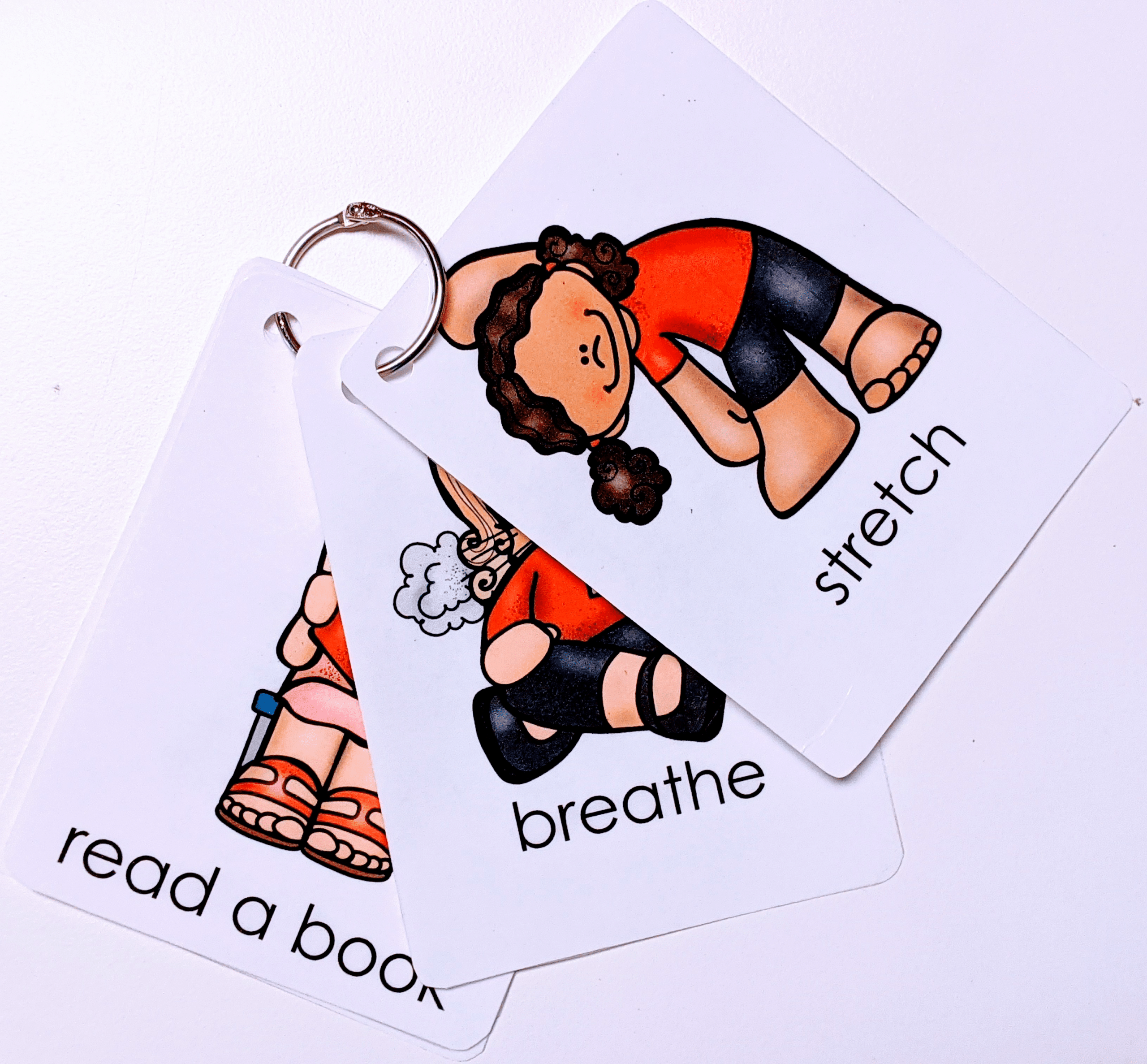
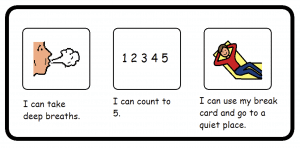
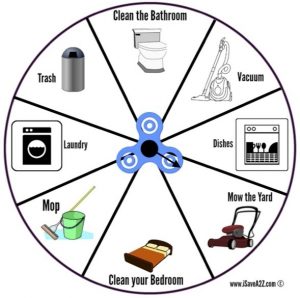
Offering choices works particularly well in heading off “noncompliant” behavior, such as refusal to engage in an activity. Can you think of a situation that often triggers your child to refuse an activity? How might you offer choices to help empower your child?
Main Takeaways
Choices are a great way to help children feel independent, while providing structure. Offering choices for foods, activities, and even tasks they don’t love can motivate them to do those things willingly.
For more tips on using ABA strategies visit our Youtube channel.
You can find more articles on a variety of ABA strategies here.
Understanding Challenging Behavior
Your child is screaming and won’t stop. She does this every night at dinnertime, and you’re running out of patience. What do you do?
When you find yourself with fraying nerves and feel unsure of how to handle the situation, it can be helpful to take a step back and observe. If you can describe your child’s behavior based solely on what you observe, and separate this from how it makes you feel, you might be able to figure out why your child is engaging in the behavior. Then, you can use targeted strategies to address the behavior and bring peace to the evening routine.
The concepts that we will discuss in this blog series come from the field of applied behavior analysis, or ABA for short. The techniques may be useful for parents who have children with autism or related special needs, as well as for families of neurotypical children. After all, challenging behavior is a part of being human! It’s something that all parents confront at some point. The good news is that there are tried and true ways to shape behavior into more positive forms – methods that are compassionate and effective.
Step 1: Describe the behavior
When you describe a challenging behavior using objective terms, you bring yourself closer to understanding why it’s occurring and how you might be able to address it.
For example, if your child is having tantrums, what does that look like? What is the child doing, or not doing, and how long does it last? For example, a child who throws themself on the floor and cries for 10 minutes might need a different set of strategies than a child who runs around dumping or throwing toys. Keep a log of the date, time of day, any context surrounding the behavior and what the behavior looked like.
Step 2: Figure out the behavior’s function
Most behavior serves a purpose for your child and can also tell you something about their needs. In the applied behavior analysis field, we think of behavior as having four main functions. We explain them using the acronym E.A.T.S.:
- Escape/Avoidance
- Attention (from others)
- Tangible (access)
- Sensory (self-soothing)
Let’s break that down a little bit.
Escape/Avoidance behavior occurs because the child wants to get away from something or someone. For example, if you suggest going for a walk, and your child yells, “No!” and flops on the ground, they are communicating that they do not share your desire for a walk. You may be tempted to just drop it. Understand that if you do, you are teaching your child that the best way to avoid an activity is to drop to the ground and yell.
On the other hand, if you use proactive strategies designed to encourage your child to participate in the walk, they may learn to enjoy walking and be less inclined to protest in the future.
Attention from Others involves behavior your child uses to get social attention, which could be positive or negative. For example, how many of us have children who interrupt us every time we’re in a conversation with a friend or neighbor? If our children successfully gain our attention by interrupting, that serves to reinforce the behavior and increases the likelihood that it will happen again.
If we instead use strategies to help our children wait patiently or use more appropriate behavior to get our attention, they learn impulse control, and we might find ourselves enjoying uninterrupted conversations more often!
Tangible (Access) behavior occurs when a child tries to physically gain access to something they desire.
For example, if Zoey is playing with a toy, and her sister, Olivia, comes and pulls her hair, Zoey may drop the toy and run off crying. Olivia then learns to use similar behavior to gain access to Zoey’s toys in the future. To keep Zoey safe and happy and set boundaries for Olivia, Olivia and Zoey’s parents could prompt Olivia to appropriately ask Zoey for a turn with the toy and reinforce Olivia’s request with the desired toy.
Sensory behavior feels internally pleasing to the child in a sensory way and can be connected to one or more senses–sight, smell, hearing, taste, or touch. For example, nail biting, rocking back and forth, and thumb sucking can produce a pleasant internal feeling or remove an unpleasant feeling.
Behavior that falls into this category typically occurs across multiple settings and environments and is considered self-reinforcing or self-stimulating, so the act of engaging in the behavior increases the likelihood that it will happen again in the future. As we mentioned in our post about celebrating neurodiversity, the ABA field has evolved to accept these stimulating behaviors, like hand-flapping and bouncing, as long as they don’t impede the child’s social interactions and learning.
Main Takeaways
Challenging or difficult behaviors test the patience of even the most compassionate parents. Taking a moment to mentally step away from the situation and observe the behavior objectively can be really helpful. As you get more comfortable being an objective observer of your child’s behavior, you’ll find yourself better able to figure out what exactly is happening, why it’s happening, and what may be causing the behavior to reoccur.
Understanding challenging behavior in this way is the first step to managing it. In our next post in this series, we’ll give you some effective strategies for addressing challenging behavior.
Download free printable positive behavior change resources.
For more tips on using ABA strategies visit our Youtube channel.
As the autism awareness movement has evolved to champion autism acceptance and neurodiversity, Applied Behavior Analysis (ABA) therapy has also embraced neurodiversity. Today an increasing number of ABA therapists are offering therapy that blends best practices from developmental and behavioral intervention frameworks. This modern approach draws on the effectiveness of previous therapy techniques and adapts those tools to better serve our current generation of children and families.
The Evolution of ABA Therapy
In the 1960s, Dr. O. Ivaar Lovaas pioneered ABA for children with autism by using behavioral principles to teach them new skills. Lovaas used Discrete Trial Training (DTT)—high levels of repetition, prompting, modeling, and reinforcement—to achieve results. However, Lovaas’ methods used not only reinforcement but also punishment, which proved counterproductive for children whose lives the therapy was meant to improve. Over time, ABA has shifted away from DTT to play-based, naturalistic therapy.
ABA therapists now rely on reinforcement-based procedures and the field has moved away from exclusively adult-directed tasks to therapy sessions that involve a more natural back-and-forth between the therapist and the child. Therapists and children share control over the direction of activities, and clinicians design treatment based on the natural course of skills progression that occurs in child development. These more “developmental” models of therapy teach children to say “big truck,” or “red truck,” before “I want truck please.” This is in keeping with how children naturally learn to communicate – they learn to speak in two word phrases that have a noun and modifier, before they learn to speak in sentences.
The field of ABA has also grown to recognize and accept behaviors that were previously targeted for “extinction,” including “stimming” (stimulating behaviors like hand-flapping, bouncing, and rocking). When these behaviors do not interfere with a child’s daily life, they are no longer considered to be “maladaptive” and thus, a focus is not put on reducing their frequency. A child who enjoys fiddling with straws is permitted to engage in the stimming behavior when it’s not impeding with social interactions and learning.
Child-Centered ABA Therapy
At Kyo we believe that the right approach for our field is to take a naturalistic and child-centered approach to therapy. To us, autism acceptance means understanding each individual for the gifts that they bring to the world and using their personal interests to guide each therapy session. Each person with ASD has a unique set of motivations, wishes, fears, and triggers. We learn as much as we can about each client and family, in order to design engaging activities that help children make meaningful, measurable steps toward independence.
In a traditional DTT approach to therapy, a child might be taught to identify colors by touching flashcards placed in front of them on a table. In Kyo’s child-centered therapy model, a kid who loves balloons might be presented with different colored balloons to identify by color, with the therapist blowing up the balloon or letting it zip around the room, upon the child responding correctly. Another child, who is fascinated by vehicles might be taught to identify colors by the therapist presenting different colored matchbox cars.
Main Takeaways
Naturalistic, child-centered ABA therapy is one of the most effective ways to teach children with autism. We meet families where they are, to teach children in ways that feel comfortable for them and motivate them to develop new skills. Celebrating neurodiversity means incorporating a child’s unique personality into the therapy plan to deliver effective, purposeful treatment. The result is more meaningful moments for children and their families.
Gateway Learning Group is now Kyo
When we started over 15 years ago we were in the educational space, but we have grown since and our name no longer reflects the innovative, creative and compassionate company we are today.
Our mission is to achieve the unachievable in autism therapy. Everything we do focuses on the outcomes our work creates and making more efficient use of our time with each of the families we work with. Every minute we spend will be laser-focused on achieving the results that matter to each child’s future. Allowing for more successes, more achievements, and more joy for families, our partners, and our employees. Because we know and understand the immense impact every single accomplishment makes.
We are now Kyo. And we will walk with you, each step of the way, to make every moment count.
What is a typical day like for a Behavior Therapist?
You’d be surprised by everything that happens in the day-to-day life of a Behavior Therapist (BT). Throughout an Applied Behavior Analysis (ABA) therapy session with a child, BTs help set up effective routines and lead children in activities to develop their communication and social skills, just to name a few.
Since Behavior Therapists work directly with primary caregivers, it’s important to check in with parents at the start of each session to see how the child’s day has been so far. When I do this at the beginning of a session, I’m able to get an idea of what to expect during the session moving forward. This information also allows me the opportunity to strategize session activities around the child’s needs. A session’s activity schedule would be different for a child who is having a rough day and has had little rest, with calming activities like coloring or large motor activities to get the wiggles out. For a child who is having a great day and is fully rested, we can try more challenging activities or ones that require more concentration.
As an BT, I also help patients with their daily activities.
At the start of each session, I spend some time pairing myself with reinforcers, which means I have some fun toys on hand to give the child, as well as some fun activities to start with, so they associate me with positive reinforcement. I also run a preference assessment to identify which activities (e.g., swinging) or toys (e.g., cars) the client is motivated for that day. We try a few of these enjoyable activities, and I offer the child a few toys, to see what they’re most excited about. This is a typical strategy BTs use to help children transition into the “work” part of our program.
When we start “working”, I use the Premack Principle, which uses first/then statements to offer a fun activity immediately after the child successfully completes a harder activity. I might say, “First, let’s brush your teeth, and then you can swing.” Then, after presenting the instructions for our next activity, I’ll prompt the child to do each task and reinforce their accomplishments, while I also score the client’s progress on each skill.
When it comes to choosing programs, I generally begin with easier skills that are ready to be mastered, like saying “Hi” when someone walks into a room. This helps build the behavior momentum towards more challenging programs; this helps children feel good and keeps them engaged.
During sessions, I often lead recreational activities to help children develop their skill sets and have fun.
For example, I might coordinate an arts and crafts session, so that the child can draw pictures while learning how to identify shapes and colors. Or, I might set up a series of movie clips for the child to watch when learning to identify the emotions of others. I might also use games and puzzles to help teach a kiddo how to ask for help or to demonstrate turn-taking.
Towards the end of the session, I request help from the child to clean up their activity area and give the guardian an update on how their child is doing in terms of their progress on programs, which I have ready in my detailed notes from the session. Then, I complete my communication log notes, describing for medical care providers the activities of the day and measuring the child’s outcomes. The best feeling in the world is when I can share a major moment with a parent, like a connection I made with a child when we connected over our shared love of dogs.
During clinical sessions, I observe patients and record their activities, based on programs written by our BCBA colleagues. In addition to running programs and implementing behavior plans, I record and report any unusual behaviors that arise. For instance, if a client begins engaging in verbal aggression for the first time throughout a regularly-held session, it is important to make note of it in clinical notes so as to strategize extinction techniques with my BCBA. Doing so can help eliminate the unwanted behavior before it becomes habitual.
Working with children with autism as a Behavior Therapist is a uniquely rewarding experience. If you enjoy working with children and are eager to help children learn and achieve things they never thought they could, then the position as a BT is perfect for you.
For more information on open Behavior Therapist jobs at Kyo, visit our Careers page.
Gateway is proud to be a silver sponsor of the 2019 Bay Area Autism/DD Conference which will be held at Stanford University, Saturday, November 16th, 8:15am – 5pm.
To register: https://www.sfautismsociety.org/2019-stanford-sfasa-conference.html
Gateway’s co-founders, Colin Davitian and Melissa Willa, will be attending this year’s ABAI International Conference in Stockholm. Melissa is particularly looking forward to hearing invited speaker Dr. Doug Greer present on “How Children Develop Naming and How this Sets Life’s Prognosis”. Dr. Greer was Melissa’s grad school advisor at Teachers College, Columbia University many moons ago.
Stanford Autism Center is holding their annual PRT conference on Saturday, September 28th. Our attending clinicians are looking forward to expanding their repertoires of naturalistic intervention methods.
Keep your child learning and growing during summer break. Prepare your child for travel or vacation. Ensure a smooth back-to-school transition.
7/24 4:30- 5:30 PM Make Building Social Skills and Friendships
1800 Sutter St #300 Concord, CA
8/17 10:00-11:00 AM Make Back-to-School East
1290 B Street #120 Hayward, CA
To reserve your seat and for more information,
email jagmeet@gatewaylg.com
Gateway is excited to be hosting a booth at the upcoming Mardi Gras for Autism in Fullerton.
On February 1st, during CalABA’s 2019 conference in Long Beach, Gateway’s CEO, Melissa Willa, will lead a panel discussion on the topic of “Treatment Planning: Dosage, Duration, and Discharge”. Melissa will be joined by Dr. Bryna Siegel, Executive Director of the Autism Center of Northern California, Dr. Linda Haymes, Associate Professor/Chair Special Education at Touro University, and Yagnesh Vadgama, Sr. Director of Clinical Care Services at Magellan Health.
The 2019 4CABA conference will be held March 29-30th at La Fonda on the Plaza in Santa Fe, New Mexico. Hope to see you there!
The 2019 CalABA conference will be held February 1st-3rd at the Long Beach Convention Center and Hyatt. Professional development opportunities at CalABA are an annual highlight for many Gateway BCBAs.
The Council for Autism Service Providers is an organization that provides support to senior level managers at organizations that provide evidence-based interventions to individuals with autism. Several Regional Directors along with Gateway’s Co-Founders will be attending this event.
Gateway Learning Group will be sponsoring and hosting a resource table at the 3rd Annual Trunk or Treat event on Saturday, October 27, 2018. Twinkies Krafts and the Hayward Unified School District have partnered to organize this event for kids with autism and special needs.

Thirteen years ago Melissa Willa and Colin Davitian had a vision to build an organization that would provide the highest quality of behavior intervention services to children with autism and their families. On October 12th, 2005, they co-founded Gateway Learning Group.
The journey started with a few dedicated staff and several families who put their trust in Gateway. Company headquarters looked a bit different back then – a couch, a few chairs, a computer – located in a modest living room in Noe Valley, SF.
Today Gateway’s team of over 400 talented professionals advances the lives of more than 600 individuals with autism every day, with compassionate, evidence-based treatment. Gateway is now recognized as a leading provider of ABA therapy throughout the state of California. HBD Gateway!
Gateway’s VP of Human Resources, Julius Schillinger, is a featured speaker at the Benefits Forum & Expo in New Orleans, September 24-26th. He will be presenting on: “Working Caregivers: The Benefits Innovation Front Line”, discussing groundbreaking employee benefits that are emerging to address the the physical, financial, and emotional toll of extended caregiving provided by the 40 million Americans who help a parent, grandparent, or other relative, with basic needs, every day.
Gateway is a proud sponsor of the Wine & Design Gala benefiting Support for Families of Children with Disabilities at the San Francisco Design Center Galleria on September 28th.

